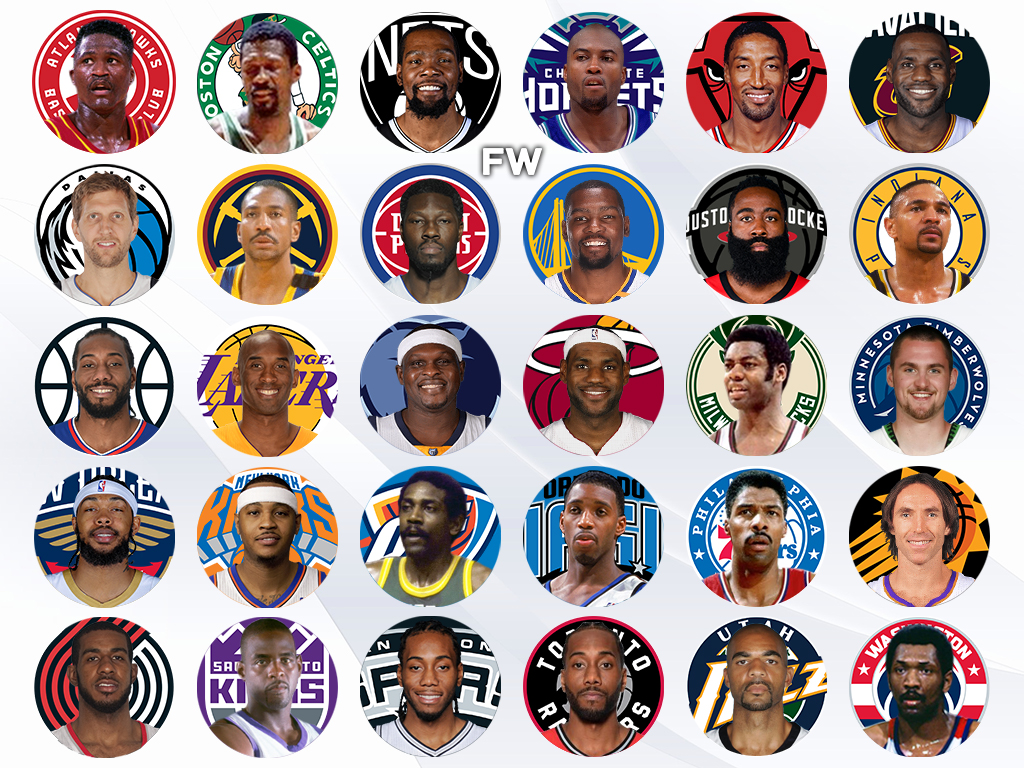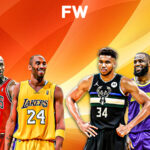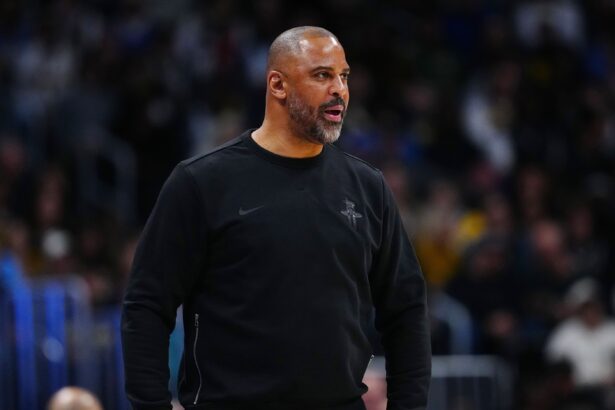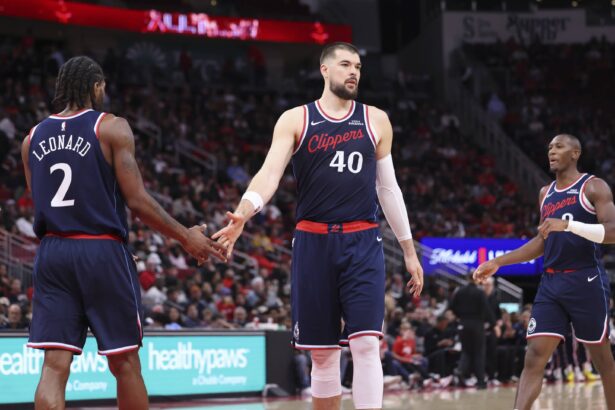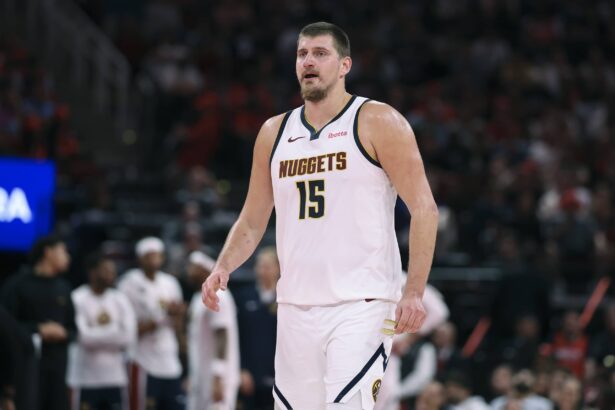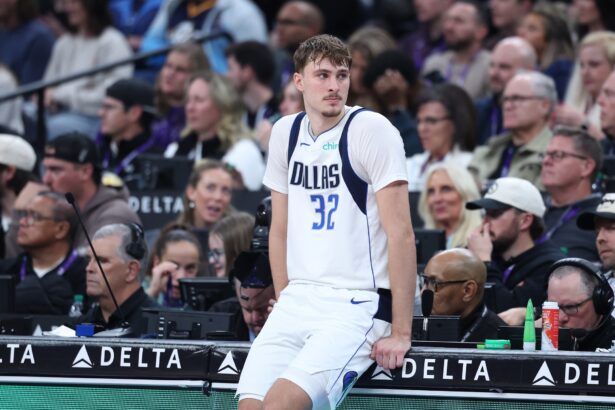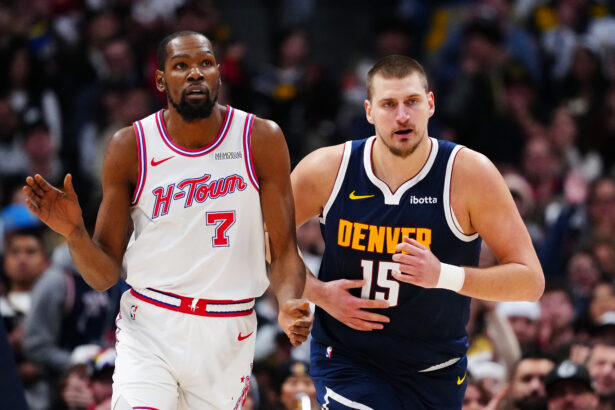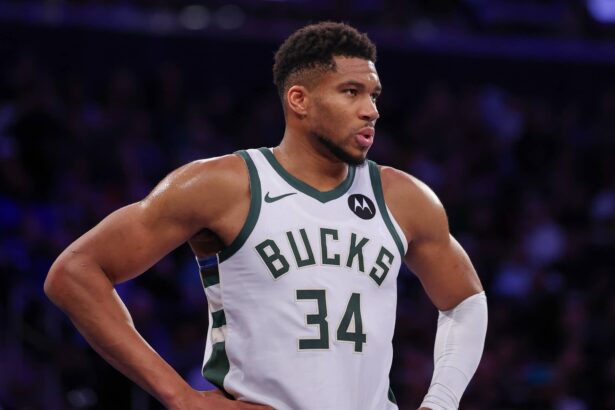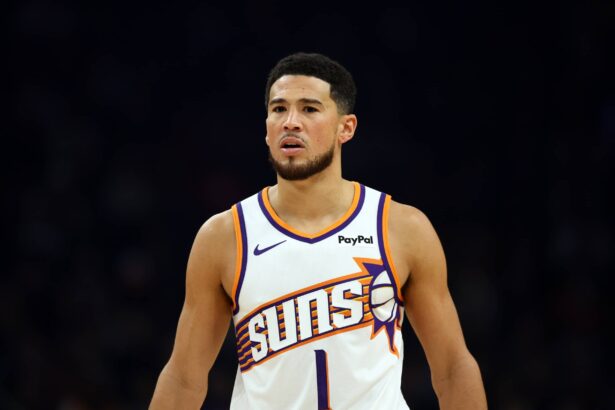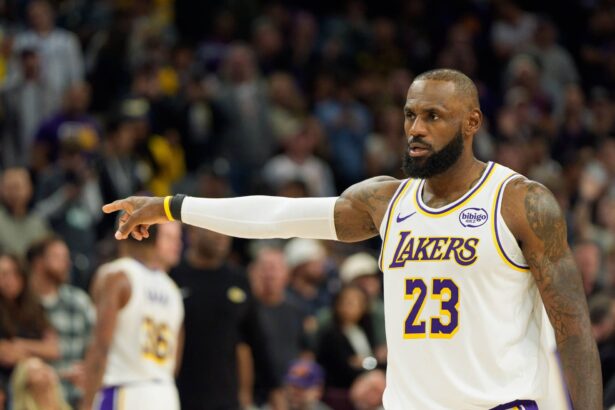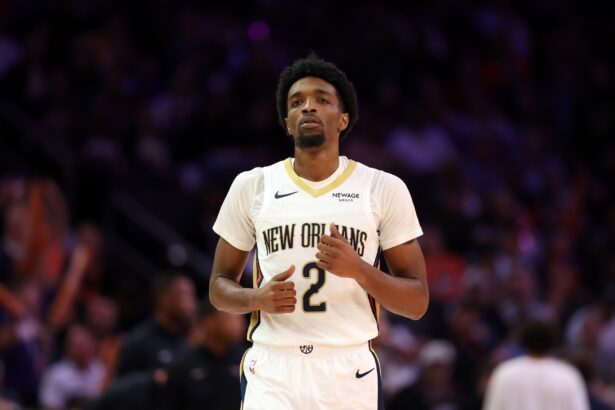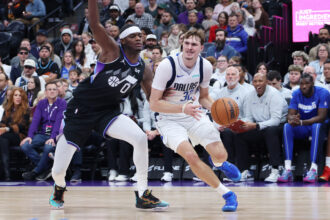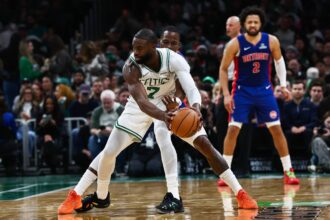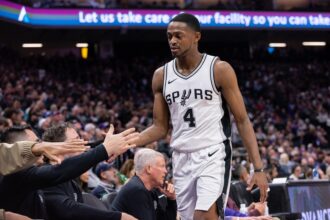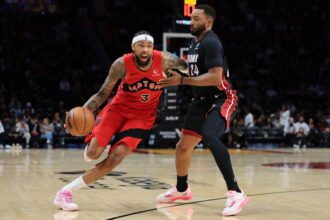Every NBA team has a general manager, scouts, coaches, and many others whose job it is to find the next great talent they need to add to their teams. There is always that perfect missing piece that every NBA front office is clamoring for and will get by any means necessary. While some teams look to build through the draft, others will try and put together the greatest trade package for that player or offer up the most money in free agency. Sometimes these deals are a hit, and they pay off huge dividends for the team making the move. Other times it can blow up in their face as a large mistake.
- Atlanta Hawks – Dominique Wilkins
- Boston Celtics – Bill Russell
- Brooklyn Nets – Kevin Durant
- Charlotte Hornets – Glen Rice
- Chicago Bulls – Scottie Pippen
- Cleveland Cavaliers – LeBron James
- Dallas Mavericks – Dirk Nowitzki
- Denver Nuggets – Alex English
- Detroit Pistons – Ben Wallace
- Golden State Warriors – Kevin Durant
- Houston Rockets – James Harden
- Indiana Pacers – Mark Jackson
- Los Angeles Clippers – Kawhi Leonard
- Los Angeles Lakers – Kobe Bryant
- Memphis Grizzlies – Zach Randolph
- Miami Heat – LeBron James
- Milwaukee Bucks – Oscar Robertson
- Minnesota Timberwolves – Kevin Love
- New Orleans Pelicans – Brandon Ingram
- New York Knicks – Carmelo Anthony
- Oklahoma City Thunder – Spencer Haywood
- Orlando Magic – Tracy McGrady
- Philadelphia 76ers – Julius Erving
- Phoenix Suns – Steve Nash
- Portland Trail Blazers – LaMarcus Aldridge
- Sacramento Kings – Chris Webber
- San Antonio Spurs – Kawhi Leonard
- Toronto Raptors – Kawhi Leonard
- Utah Jazz – Carlos Boozer
- Washington Wizards – Elvin Hayes
- Next
- 25 NBA Legends And Superstars Career-Highs In Points: Wilt Chamberlain Holds The Record With 100 Points, Kobe Bryant Is No. 2 With 81 Points
- 10 Youngest NBA Players To Win The MVP Award: Derrick Rose Was Only 22 Years Old When He Broke This Record
- 10 Youngest NBA Players To Win The Finals MVP Award: Magic Johnson Was A 20-Year-Old Rookie When He Won The Award
- The Only 3 Three-Peat NBA Teams In The Last 56 Years: Michael Jordan And Bulls Conquered The World, Shaquille O’Neal And Kobe Bryant Were Last To Win Three In A Row
- 10 NBA Stars Who Have Beaten The Most 50-Win Teams In Playoffs History
Today’s list will focus on the deal for each NBA franchise that paid off the most. No drafted acquisitions will be included unless that player was traded on the draft night, such as Scottie Pippen and Dirk Nowitzki. Every team has that one acquired player that has either turned their franchise around entirely or put them over the hump into the championship contender category. For the teams that haven’t won the championship, these are the guys that gave them the best shot to do so. Not only do we celebrate these great acquisitions with this list, but we also pay homage to the front offices that made these deals happen.
Here are the greatest acquisitions via free agency or trade in every NBA team’s history.
Atlanta Hawks – Dominique Wilkins
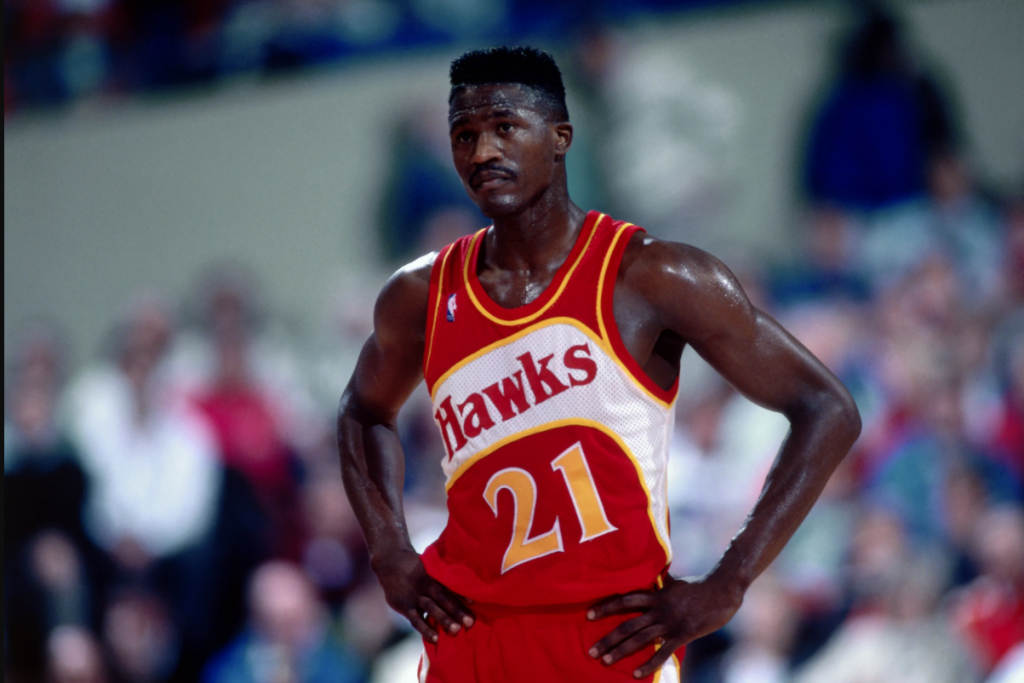
With the 3rd pick of the 1982 NBA Draft, the Utah Jazz selected Dominique Wilkins. The Jazz had been in desperate need of a superstar, and Wilkins fit that mold perfectly. Unfortunately for the Jazz, Wilkins was not on the same wavelength as the team. He almost immediately informed the Jazz that he had no intention of suiting up for them in the 1982-83 season and that they should look to trade him. The Jazz found a trade partner in September of 1982 in the Atlanta Hawks.
In one of the most lopsided trades in NBA history, the Hawks sent Freeman Williams, John Drew, and $1 million to Utah in exchange for Wilkins. To let you know just how unfair this deal was, the most valuable part of the deal turned out to be the money. Wilkins went on to become a 9x All-Star and 7x All-NBA Team selection. From 1986 through 1994, Wilkins averaged at least 25.0 PPG each season and over 30.0 PPG twice. He took home the scoring title in the 1985-86 season with 30.3 PPG in 78 games played. Even though the Hawks never got to the promised land of an NBA championship, Wilkins made them contenders and relevant around the league. Without him, those Hawks teams may have fallen into obscurity.
Boston Celtics – Bill Russell
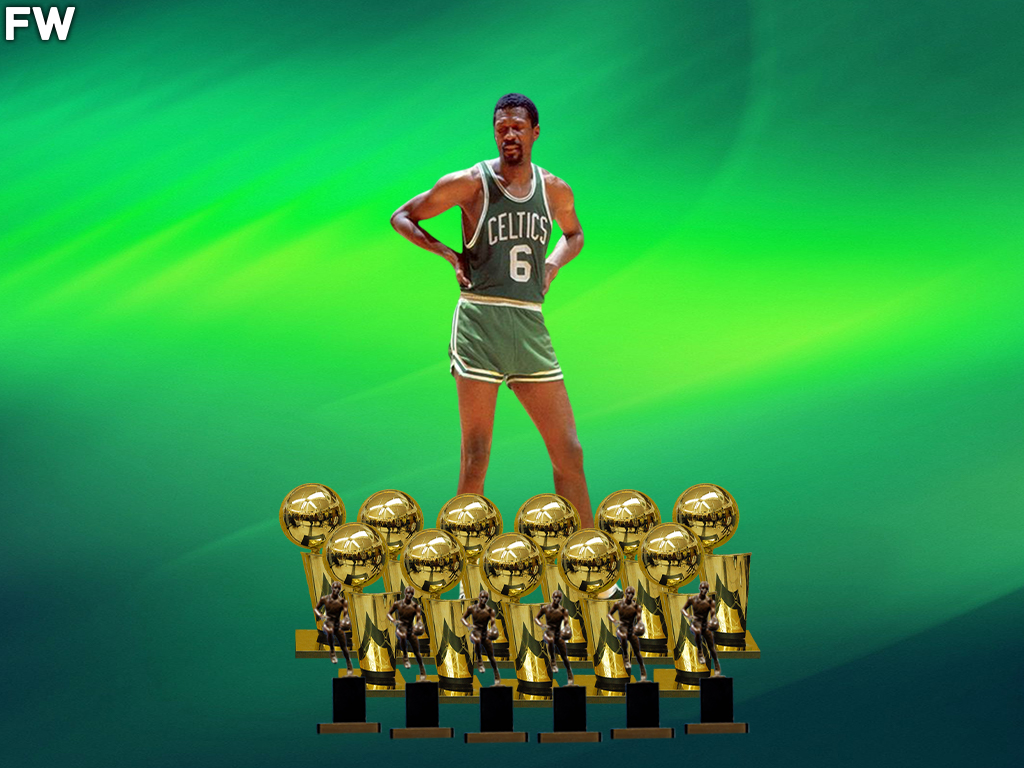
Many may not know the story behind Bill Russell’s trade to the Boston Celtics. Red Auerbach was a master negotiator during his time with Boston, and in the case of this deal, it was no different. Immediately following the 1955-56 season, Auerbach knew that he had to have the University Of San Francisco’s Bill Russell. He traded perennial All-Star Ed Macauley and the rights to Cliff Hagan to the Hawks in exchange for the No. 2 overall pick. He then negotiated the Ice Capades to be brought to Rochester so that the Royals would let Russell slide to No. 2. That is exactly what he did, and the Celtics ended up with one of the greatest to ever play the game.
Bill Russell became an NBA icon during his time with the Boston Celtics. Despite all the negativity he faced off the court due to racism and other differences, Russell thrived on the basketball court. He became a 5x MVP, an 11x NBA Champion, and is widely considered to be the best rebounder and defender in NBA history. He led the league in rebounds 4 times and averaged 22.5 RPG for his career. The NBA didn’t keep track of blocks and steals during his time, but if they did, I am sure Russell would be toward the top of both lists. It is safe to say that Bill Russell is Boston’s greatest acquisition.
Brooklyn Nets – Kevin Durant
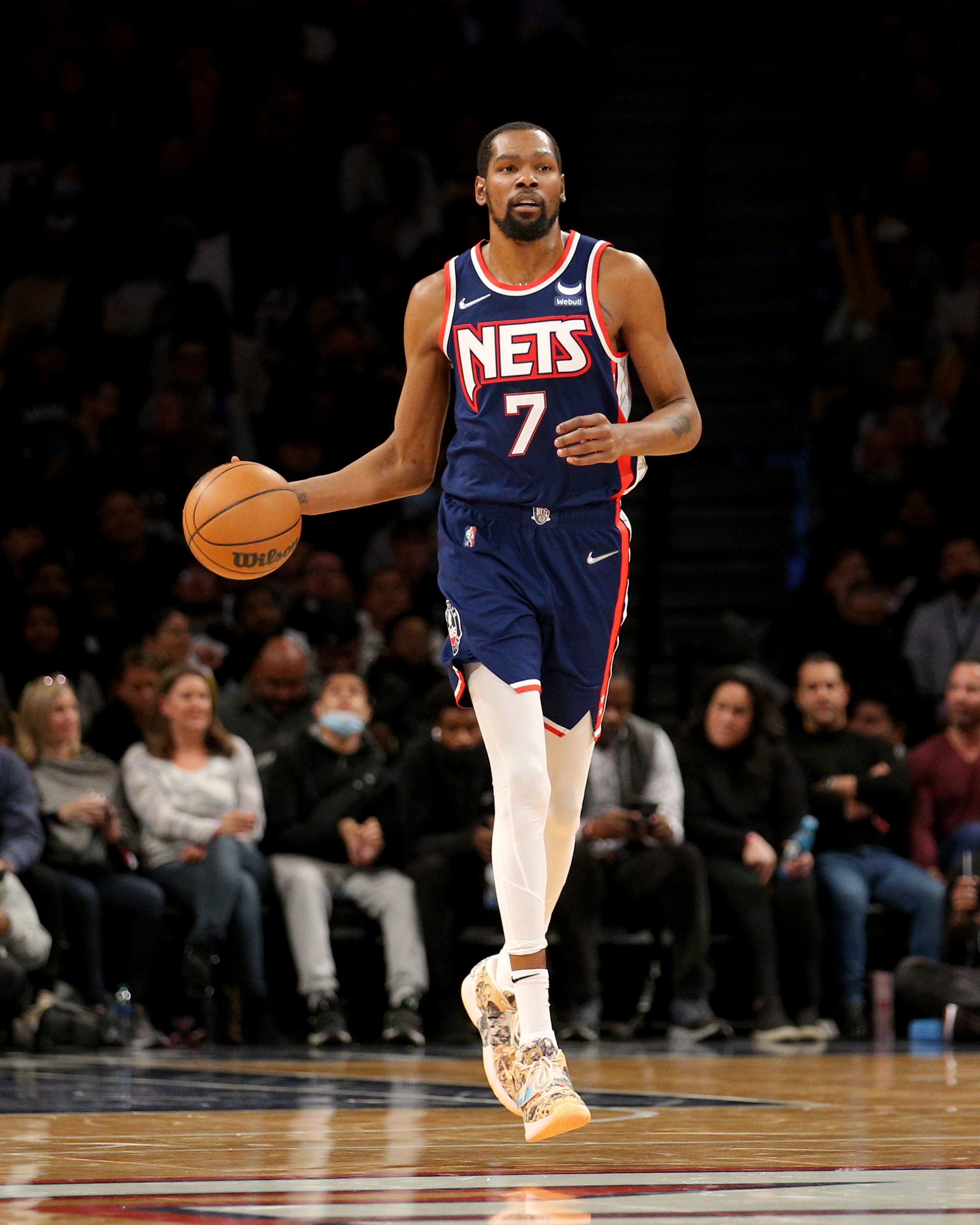
After a successful 3 seasons in Golden State, Kevin Durant was once again looking to find a new team. In the 2019 offseason, The Warriors and Brooklyn Nets came to an agreement on a double sign and trade that sent Durant and a 2020 protected first-round pick to Brooklyn and D’Angelo Russell, Shabazz Napier, and Treveon Graham to the Warriors. Brooklyn then inked Durant to a 4-year, $164 million deal. Durant was going to miss the entire 2019-20 season due to a torn Achilles he suffered in the NBA Finals just a few months earlier, but he was well worth the price, or so the Nets thought.
Here we are just 3 seasons into Durant’s tenure, and things have been rocky for Brooklyn. As previously mentioned, Durant missed the entire 2019-20 season with a torn Achilles. In 2020-21, Durant and the Nets advanced to the second round of the playoffs, only to fall in 7 games to the Milwaukee Bucks despite a monster series from Durant. In the 2021-22 season, the drama started to unfold as James Harden forced his way out of Brooklyn, Kyrie Irving could only play less than half of the team’s games due to vaccine restrictions, and the team was subsequently swept out of the first round by the Boston Celtics. Durant then shocked the NBA community by requesting a trade out of Brooklyn this summer, but after recent developments, he’s staying put at Barclays Center.
Charlotte Hornets – Glen Rice
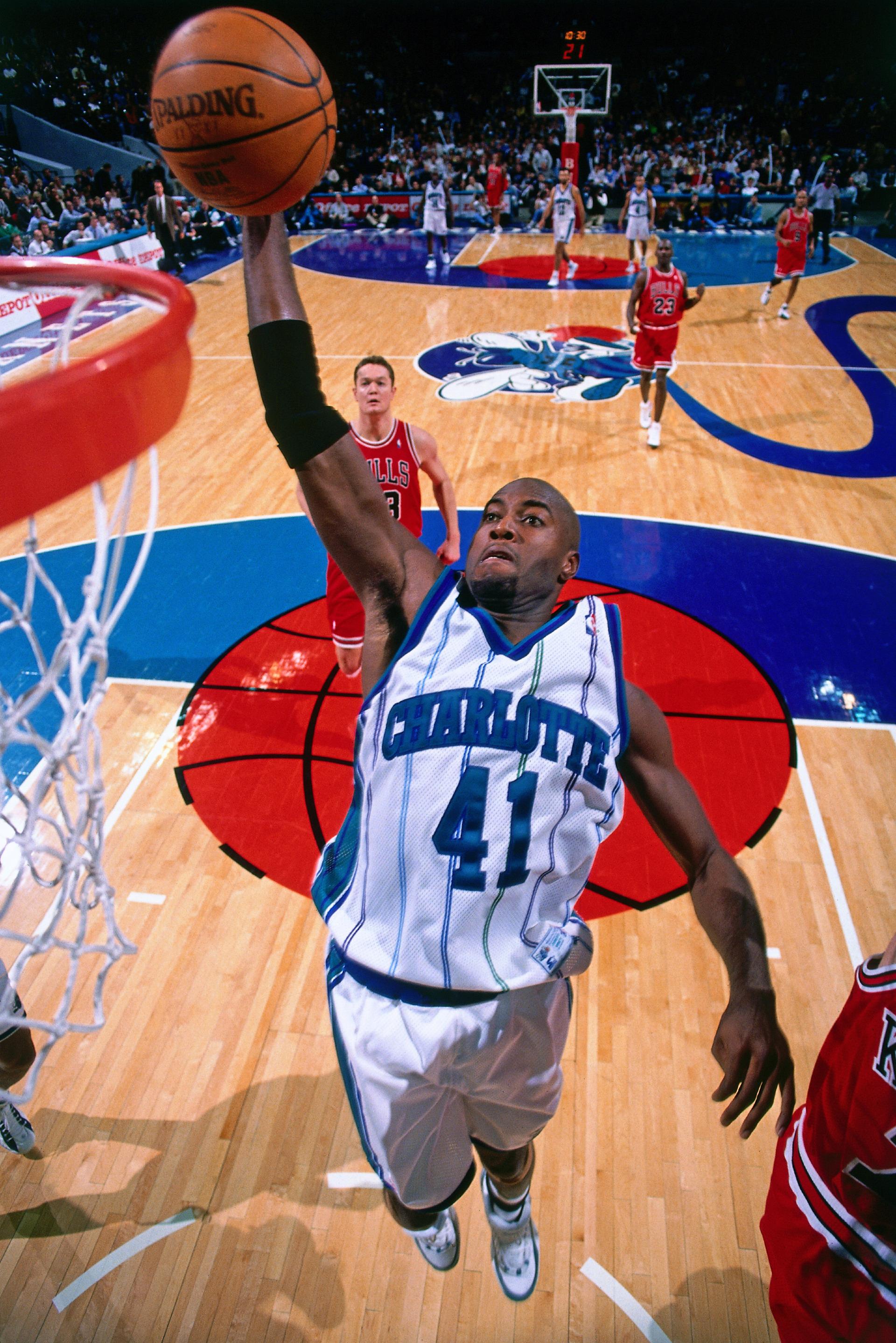
Glen Rice spent the first 6 seasons of his career with the Miami Heat from 1990 to 1995. During his time there, his talent was unquestionable as he developed into a sharp shooting 20.0 PPG scorer. After the 1994-95 season, Rice was traded by the Heat along with Matt Geiger, Khalid Reeves, and a 1996 first-round pick to the Charlotte Hornets. The Heat received LeRon Ellis, Alonzo Mourning, and Pete Meyers. It would be with the Hornets that Rice would reach the peak of his career.
Glen Rice only played 3 seasons with the Charlotte Hornets, but those 3 seasons yielded the only three All-Star selections of his career. It would also yield the only two All-NBA Team selections of his career and an All-Star Game MVP in 1997. In the 1996-97 season, Rice averaged 26.8 PPG, which was good for 3rd in the league behind only Michael Jordan and Karl Malone. In his three seasons with the team, Rice averaged 23.5 PPG and 4.4 RPG. He also led the league in three-point percentage in 1996-97 when he shot 47.0% from beyond the arc. Rice’s three incredible seasons in Charlotte make him their greatest acquisition by trade or free agency.
Chicago Bulls – Scottie Pippen
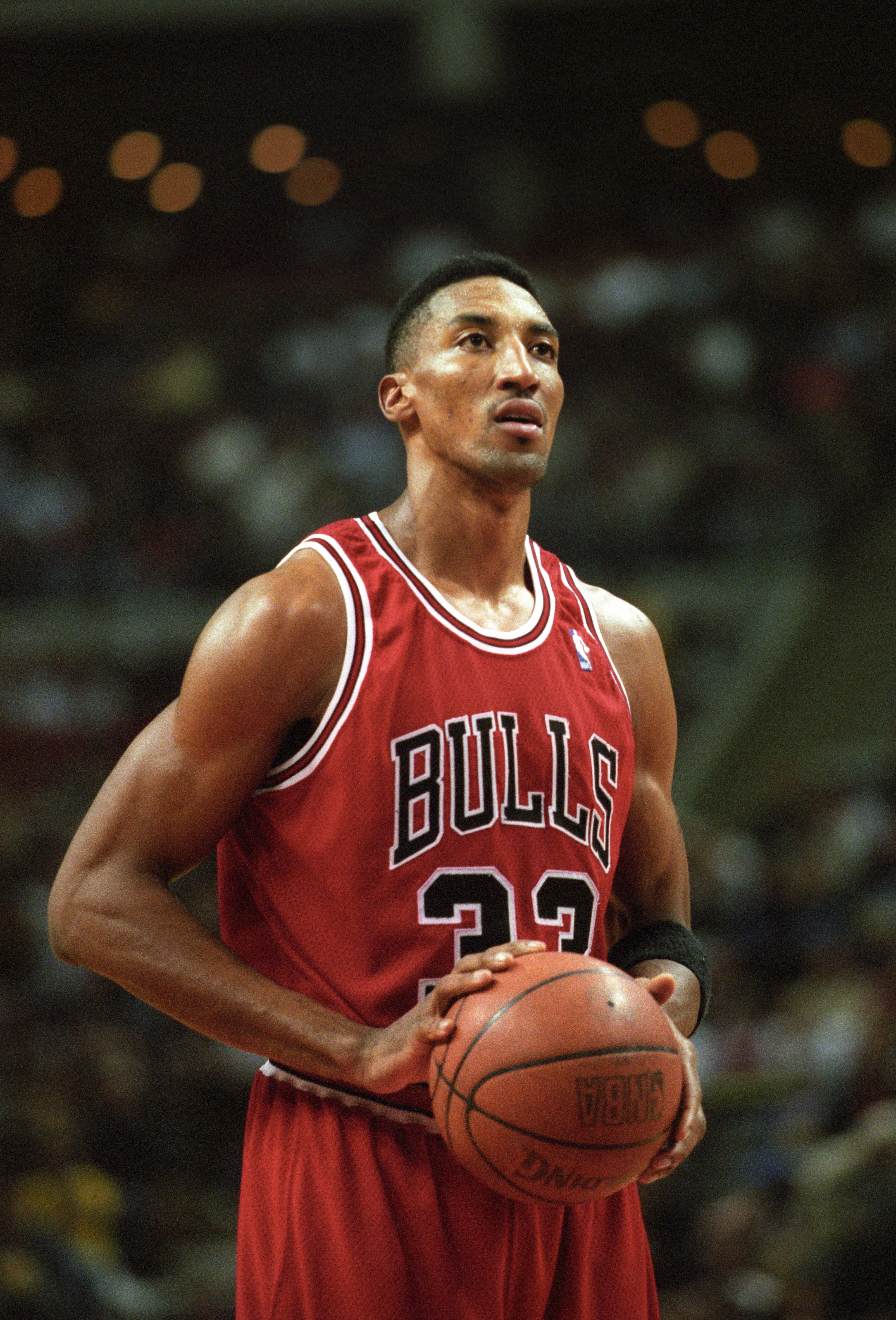
Before the 1987 NBA Draft, Chicago Bulls GM Jerry Krause knew he needed one more piece to help his team compete with the NBA’s best like the Lakers and Celtics at the time. He had his eyes set on a 6’8” small forward out of the University Of Central Arkansas named Scottie Pippen. On the night of the NBA Draft, Pippen was selected 5th overall by the Seattle SuperSonics, three picks before Chicago was set to select their player. The Bulls selected Olden Polynice, who Krause knew Seattle had wanted to strike a deal for Pippen. The Bulls decided to attach a 1988 second-round pick and a 1989 first-round pick to Polynice, which was enough for Seattle to pull the trigger. The deal would alter NBA history as we know it.
Pippen went on to become one of the best two-way players in the game and the perfect complimentary piece to Michael Jordan. With Pippen, the Bulls would win six championships, including 2 three-peats during the 90s. Pippen would be named a 7x All-Star, 7x All-NBA Team Selection, and a 10x All-Defensive Team selection. During his career with the Bulls, Pippen averaged 17.7 PPG, 6.7 RPG, 5.3 APG, and 2.1 SPG. He is responsible for some of the best defensive efforts in the playoffs en route to those six championships, locking up the opposing team’s best or second-best offensive weapons every night. Scottie Pippen was the best decision any GM of the Bulls has ever made aside from drafting Michael Jordan, of course.
Cleveland Cavaliers – LeBron James
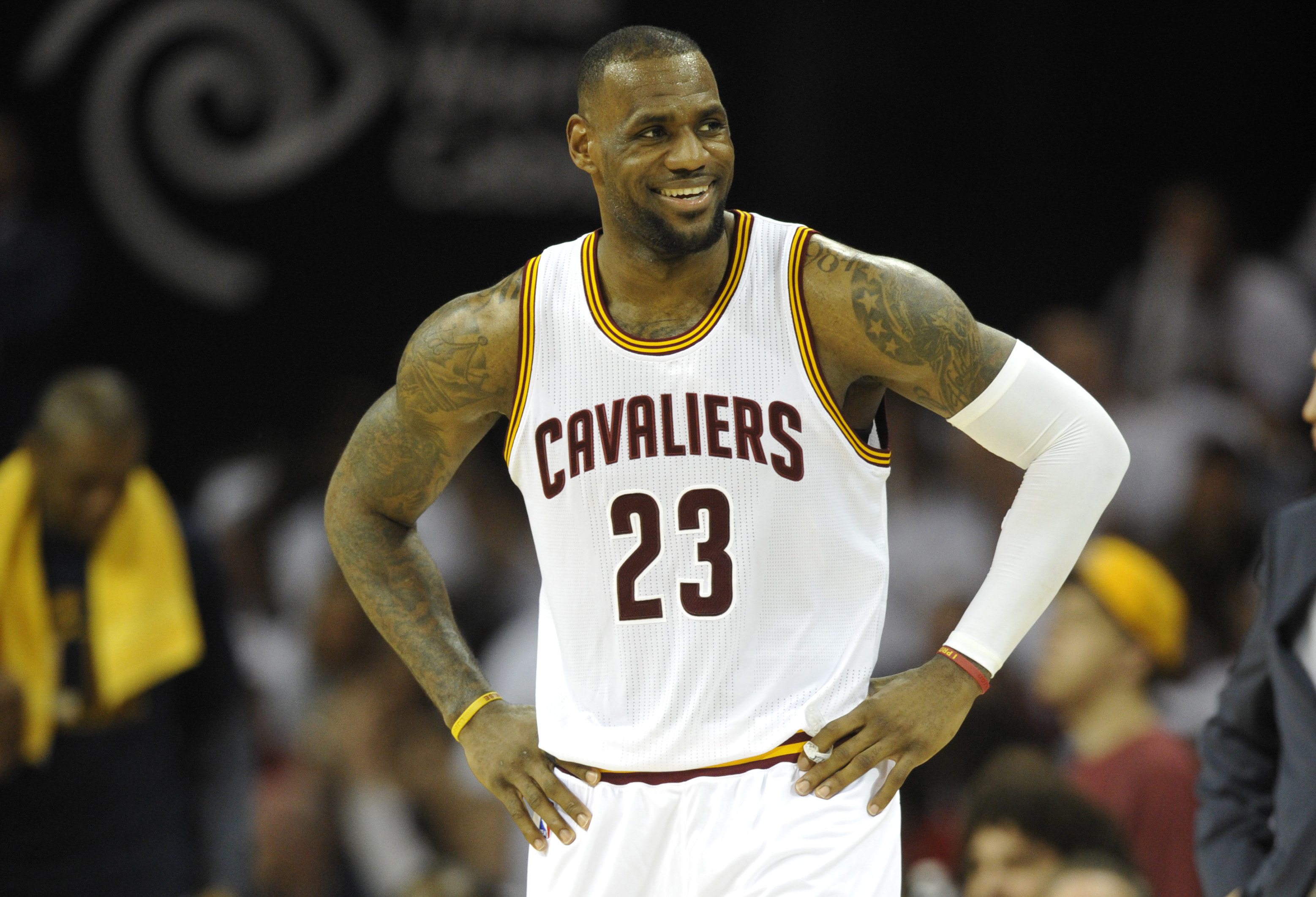
The Cleveland Cavaliers made the perfect selection of drafting LeBron James with the No. 1 overall pick back in the 2003 NBA Draft. However, it is his second stint in Cleveland when he signed as a free agent in 2014 that lands him on this list today. After spurning Cleveland in the 2010 offseason for the Miami Het, James spent 4 seasons in Miami, winning 2 titles. After the 2013-14 season and a Finals loss to the Spurs, James decided it was time to come home to Cleveland and finish what he started in 2003. Cavaliers fans are forever grateful he did.
LeBron would lead the Cavaliers to the NBA Finals in 2015 but fell to the Golden State Warriors. In 2016, James would lead the greatest comeback in NBA history. After falling down 3 games to 1 against the same Warriors from the year before, James went nuclear the rest of the series to help capture the franchise’s first championship ever. He averaged 29.7 PPG, 11.3 RPG, and 8.9 APG in the 2016 Finals and made history along the way. James would get the Cavs to 2 more Finals appearances but would fall to the Warriors each time. Regardless of the 1-3 record in the NBA Finals in his second stint, LeBron’s 2016 season easily makes him the Cavaliers’ best acquisition.
Dallas Mavericks – Dirk Nowitzki
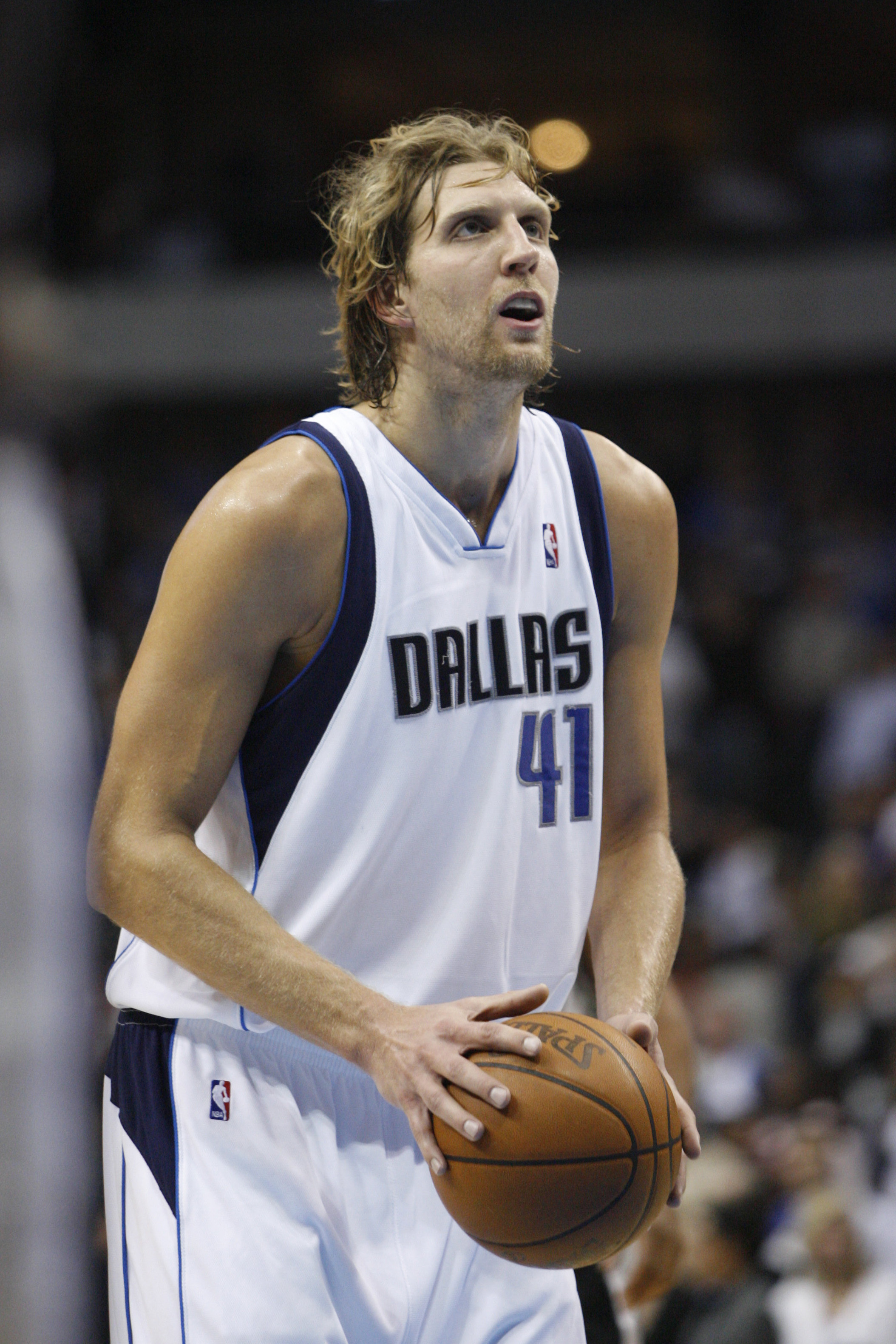
This deal was brought to us by the brilliant basketball mind of Don Nelson. Not only did Nelson serve as the Mavericks coach in 1998, but he was also the team’s GM at the time. On draft day 1998, Nelson and the Mavs saw something in a 7-footer baller from Germany that 29 other teams did not see at the time. The Mavericks sent Michigan standout Robert Traylor to the Bucks in exchange for Pat Garrity and Dirk Nowitzki on draft night, but the moves were not done yet. Garrity was then used to land Steve Nash from Phoenix as well, setting up for one of the best duos in the league at the time.
Nowitzki went on to become one of the greatest to ever play the power forward position in NBA history. He amassed over 31,000 points for the Mavs in his 21-year career. He became MVP in 2007 and led one of the greatest title runs in history in 2011 for the first title in Mavericks franchise history. He averaged 27.7 PPG and 8.1 RPG in the 2011 playoffs to lead the Mavericks to their first Finals since 2006. In the Finals, Dirk and the Mavs matched up with the newly formed superteam In Miami that consisted of LeBron James, Dwyane Wade, and Chris Bosh. Dirk took down the Heat in 6 games behind 26.0 PPG, 9.7 RPG, and 2.0 APG capturing Dallas’ first championship in franchise history. This, combined with the 21 years he gave to the organization, makes him their greatest acquisition.
Denver Nuggets – Alex English
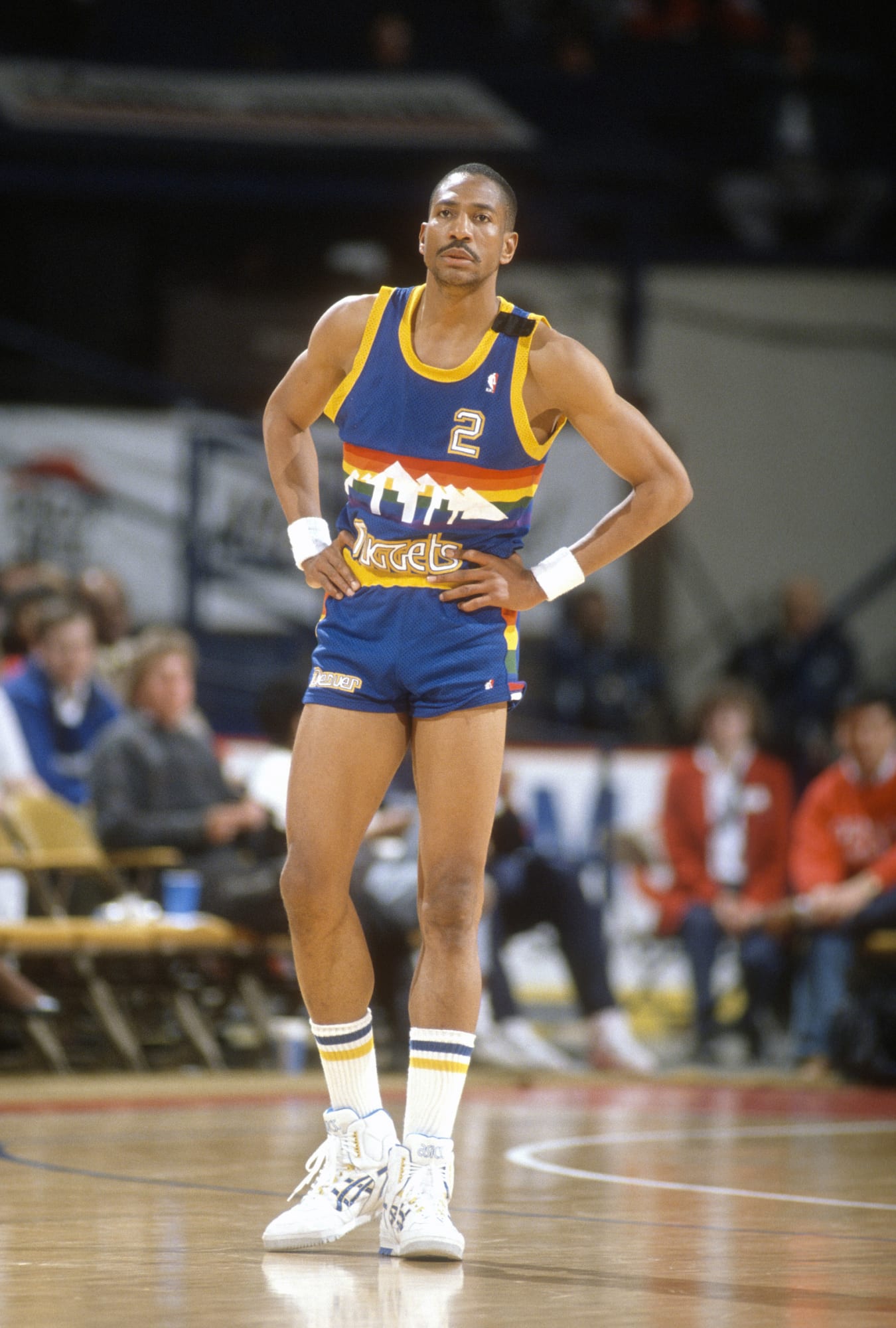
From 1976 to 1980, Alex English was buried on the bench in Milwaukee and hidden in Indiana by poorly performing teams. That would all change for him midway through the 1979-80 season. The Pacers decided to trade English along with a 1980 first-round pick to the Denver Nuggets in exchange for ABA legend George McGinnis. By the time McGinnis got to Indiana, he was in the later stages of his career and only lasted 2 more seasons in the NBA. English was another story.
In his first full season with the Nuggets, Alex English averaged 23.8 PPG on 49.4% shooting. The next 8 seasons that followed would make history. English would be named to 8 straight All-Star Teams averaging 27.3 PPG over that stretch and shooting 51.2% from the field. He would also become the first player in NBA history to record 8 straight 2,000-point seasons. Among all of his accomplishments, English can boast that he outscored everyone in the entire decade of the 1980s. He may have never delivered a title to the city of Denver, but Alex English is still one of the greatest players to ever wear their uniform.
Detroit Pistons – Ben Wallace
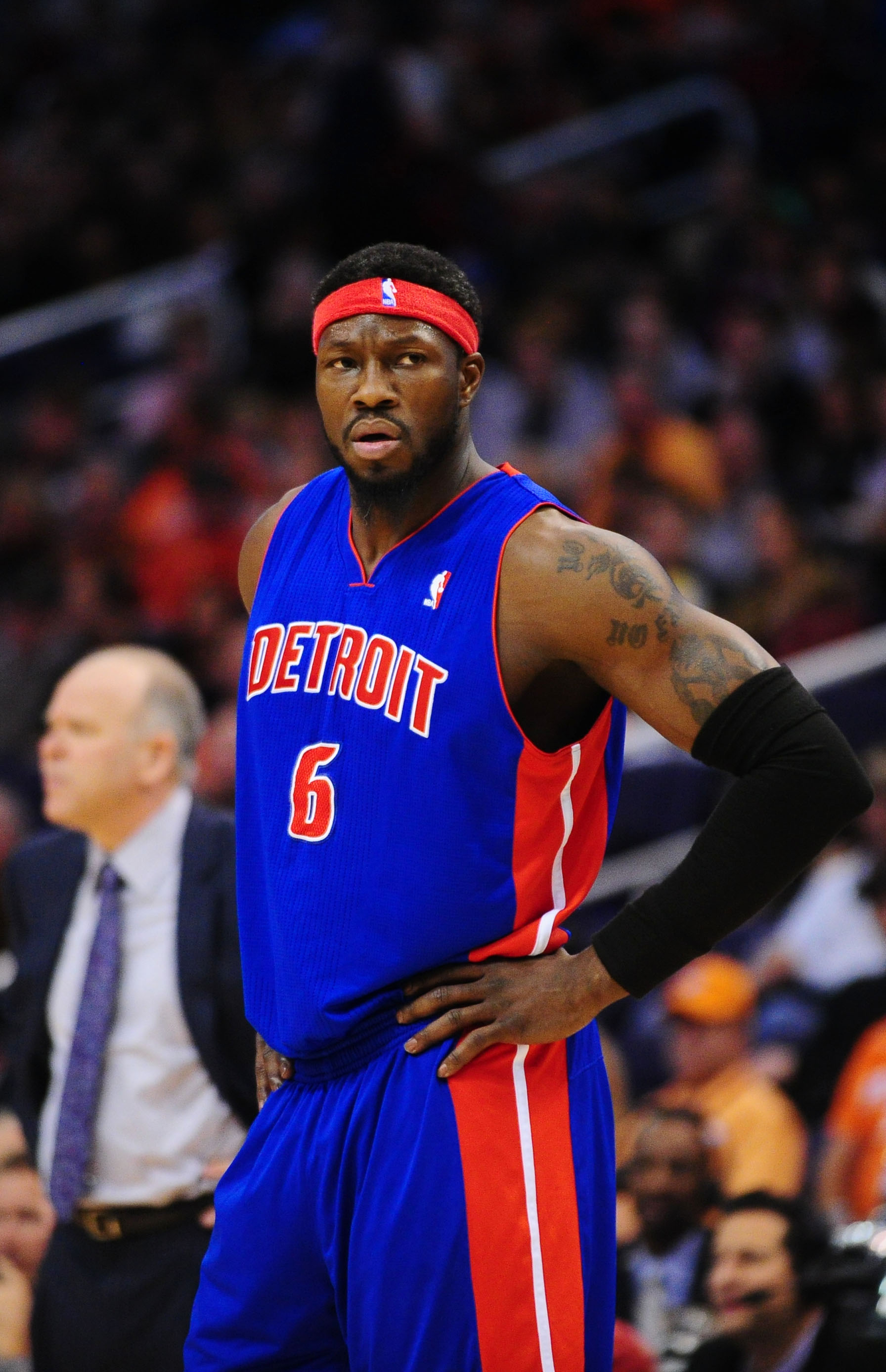
For the first 4 seasons of his career, Ben Wallace struggled to find a role with both the Washington Bullets and Orlando Magic. He spent the first three years coming off of the bench in Washington, starting just 32 games in three seasons. He was then traded to the Magic where he started all 81 games and had the first season in which he recorded over 100 blocks. The Magic then decided to include Wallace in a deal to the Detroit Pistons that included sending Grant Hill back to Orlando in return. It would be in Detroit that Wallace would become an NBA legend.
In just his second season with the Pistons, Wallace led the league in blocks and rebounds and was named the Defensive Player of the Year. The following season, he was named an All-Star for the first time and again led the league in rebounds while taking home the Defensive Player of the Year award yet again. In his 3rd season with the team, he proved to be the defensive catalyst needed to knock off the Los Angeles Lakers for the first Pistons title in 15 years. He would again win the Defensive Player of the Year award in back-to-back seasons in 2005 and 2006. Wallace proved to be one of the most valuable defensive players in Pistons and league history, which is saying something for a franchise that prides itself on defense.
Golden State Warriors – Kevin Durant
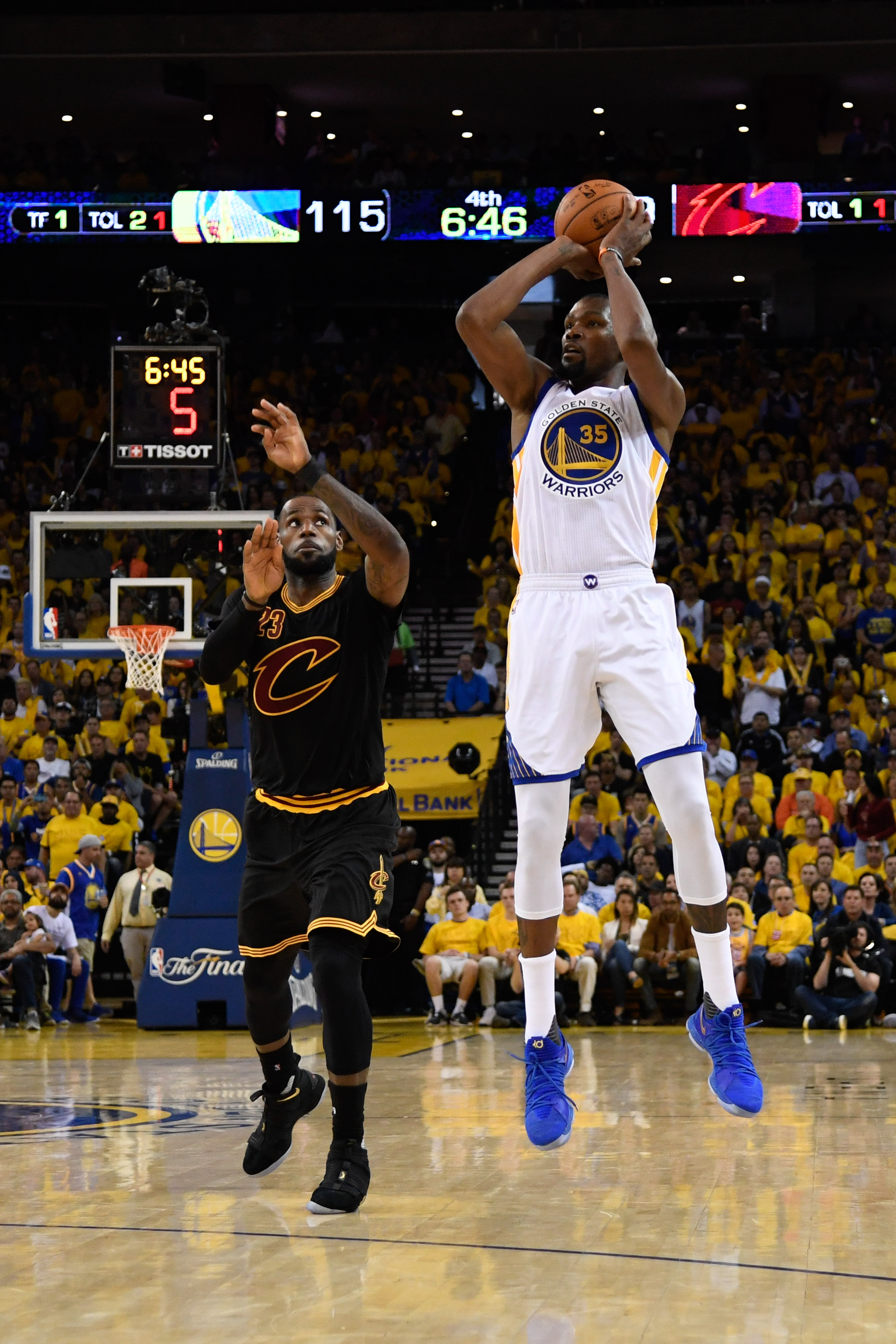
Regardless of how you feel about Kevin Durant’s move to the Warriors in 2017, he delivered, so stay mad. Before coming to the Warriors, Durant was an MVP of the league and a 4x league scoring champion. After blowing a 3-1 lead to the Warriors in the 2016 playoffs, Durant decided to join them and form what can only be described as The Avengers on the NBA. He signed as a free agent initially on a 1-year, $30 million deal, which turned into a 2-year extension worth $53 million. What ensued is one of the most dominant 3-year stretches ever.
In his first season with the Warriors, Durant led them back to the NBA Finals and a rematch with LeBron James and the Cleveland Cavaliers. Durant delivered, taking down the Cavs in 5 games and was named Finals MVP. He again led the Warriors back to the Finals against LeBron and the Cavs in 2018. This time it was even less of a competition as the Warriors swept the Cavs in 4 games. Durant was again named Finals MVP with averages of 28.8 PPG, 10.8 RPG, and 7.5 APG. The following season, Durant, unfortunately, tore his Achilles tendon as the Warriors fell to the Toronto Raptors in the NBA Finals. Again, regardless of how it makes you feel, Durant’s dominant tenure in Golden State makes him their greatest acquisition.
Houston Rockets – James Harden

Before having one of the greatest offensive peaks in NBA history with the Rockets, James Harden was one of the best players in basketball. He was even named the NBA’s Sixth Man of the Year in the 2011-12 season. Harden was a budding superstar, and executives around the league knew it. In October of 2012, Harden was traded to the Houston Rockets along with Cole Aldrich, Daequan Cook, and Lazar Hayward. The Thunder got Jeremy Lamb, Kevin Martin, 2 first-round picks, and a second-round pick in return. It was with Houston that Harden would come into his own as a pro.
Harden would spend the next 9 seasons in Houston and peak as one of the Top 4 players in basketball. He would win his first assists title in 2017 with 11.2 APG. He would then win 3 straight scoring titles from 2018 to 2020. He won the MVP award in 2018 with averages of 30.4 PPG, 5.4 RPG, and 8.8 APG on 45/36/85 shooting splits. In his 9 seasons with Houston, Harden averaged 29.6 PPG, 6.0 RPG, 7.7 APG, and 1.8 SPG. Harden had Houston in consistent contention for Conference Finals and Finals berths, although he was never able to reach the Finals with them.
Indiana Pacers – Mark Jackson

Mark Jackson did not step on the floor every night as a heavy-scoring threat. What instilled fear in opposing teams was his ability to command an offense, set the tempo, and elevate his team through his playmaking skills. That is exactly the type of player the Pacers were getting when they acquired Jackson from the Clippers in 1994. The Pacers sent Eric Piatkowski, Pooh Richardson, and Malik Sealy to Los Angeles in return for Jackson and Greg Minor.
Jackson would win the assist title in his second season with the Pacers with 11.4 APG, a career-high. He would become a catalyst for the Pacers’ contending teams during the mid and late 80s. He was the pace-setter while Reggie Miller, Jalen Rose, and Rik Smits were the scorers for the 1998 team that challenged Jordan’s Bulls in the playoffs and the vocal leader of the 2000 team that went all the way to the Finals against the Lakers. Jackson’s point guard acumen and ability to elevate his teammates make him Indiana’s greatest acquisition.
Los Angeles Clippers – Kawhi Leonard
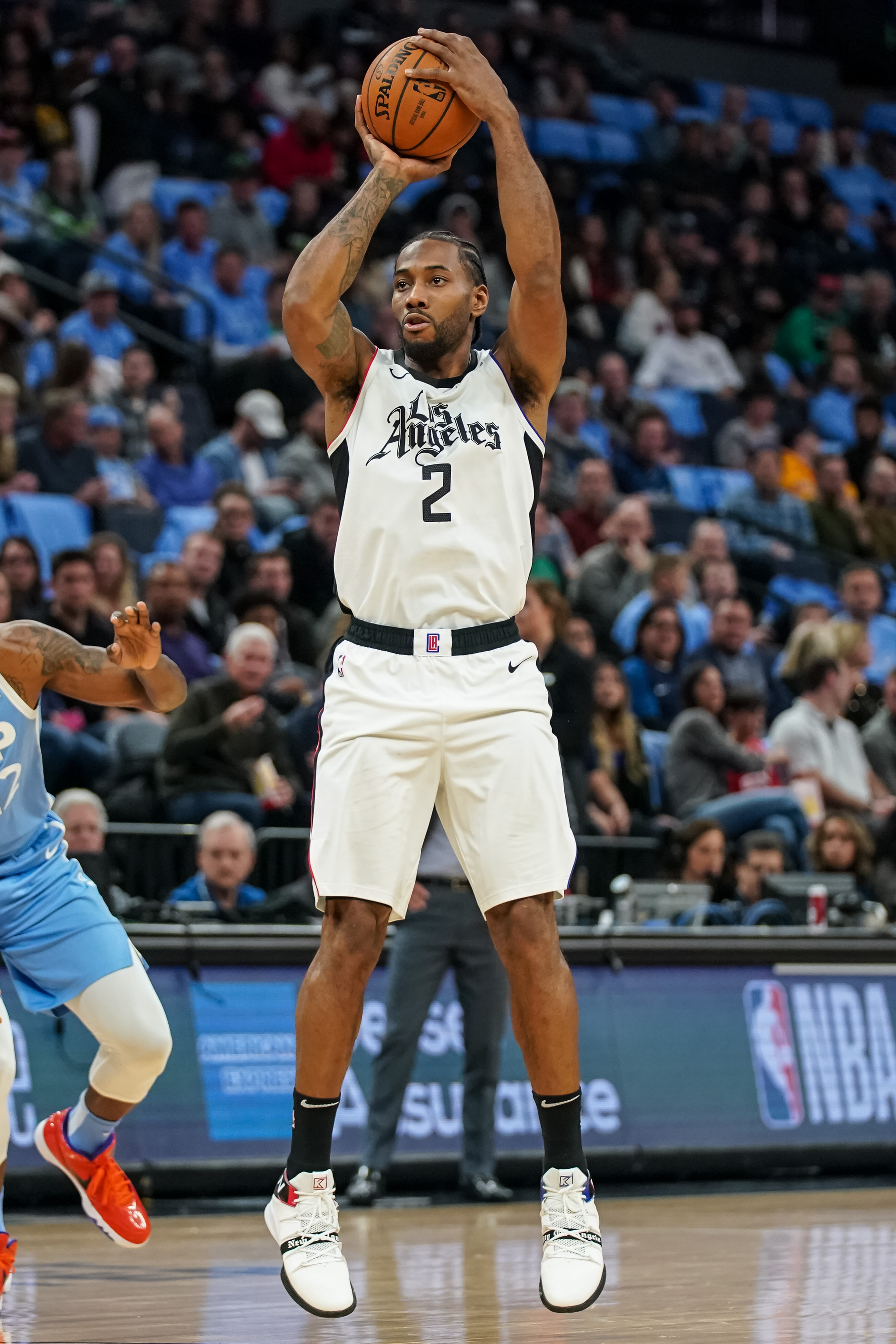
Kawhi Leonard was on top of the world headed into the 2019 offseason. He had just delivered the Toronto Raptors their first championship in franchise history and was going to be receiving a monstrous payday headed into free agency. That is exactly what happened when he agreed to a 3-year, $103 million deal with the Clippers that offseason. Kawhi’s signing also triggered a massive deal that saw Paul George land with the Clippers as well, making them the biggest threat they had been in their team’s history. Kawhi has since inked a 4-year, $176.3 million extension with the team, locking him in for the foreseeable future, which is great news for Clippers fans.
Kawhi has been battling injuries for a few seasons with L.A. but when he has been on the court, he has been brilliant. In his first season with the team, he averaged 27.1 PPG, 7.1 RPG, 4.9 APG, and 1.8 SPG. The Clippers advanced to the second round of the playoffs but blew a 3-1 lead to the Denver Nuggets. The following season, Kawhi went off again, leading the Clippers to the playoffs once again where he shined brightly. In 11 playoff games, Kawhi averaged 30.4 PPG, 7.7 RPG, 4.4 APG, and 2.1 SPG. Unfortunately, he was not on the floor when the Clippers advanced to their first Western Conference Finals due to a knee injury that kept him out of all of 2022. His return is anticipated as the Clippers should be one of the favorites in the Western Conference.
Los Angeles Lakers – Kobe Bryant
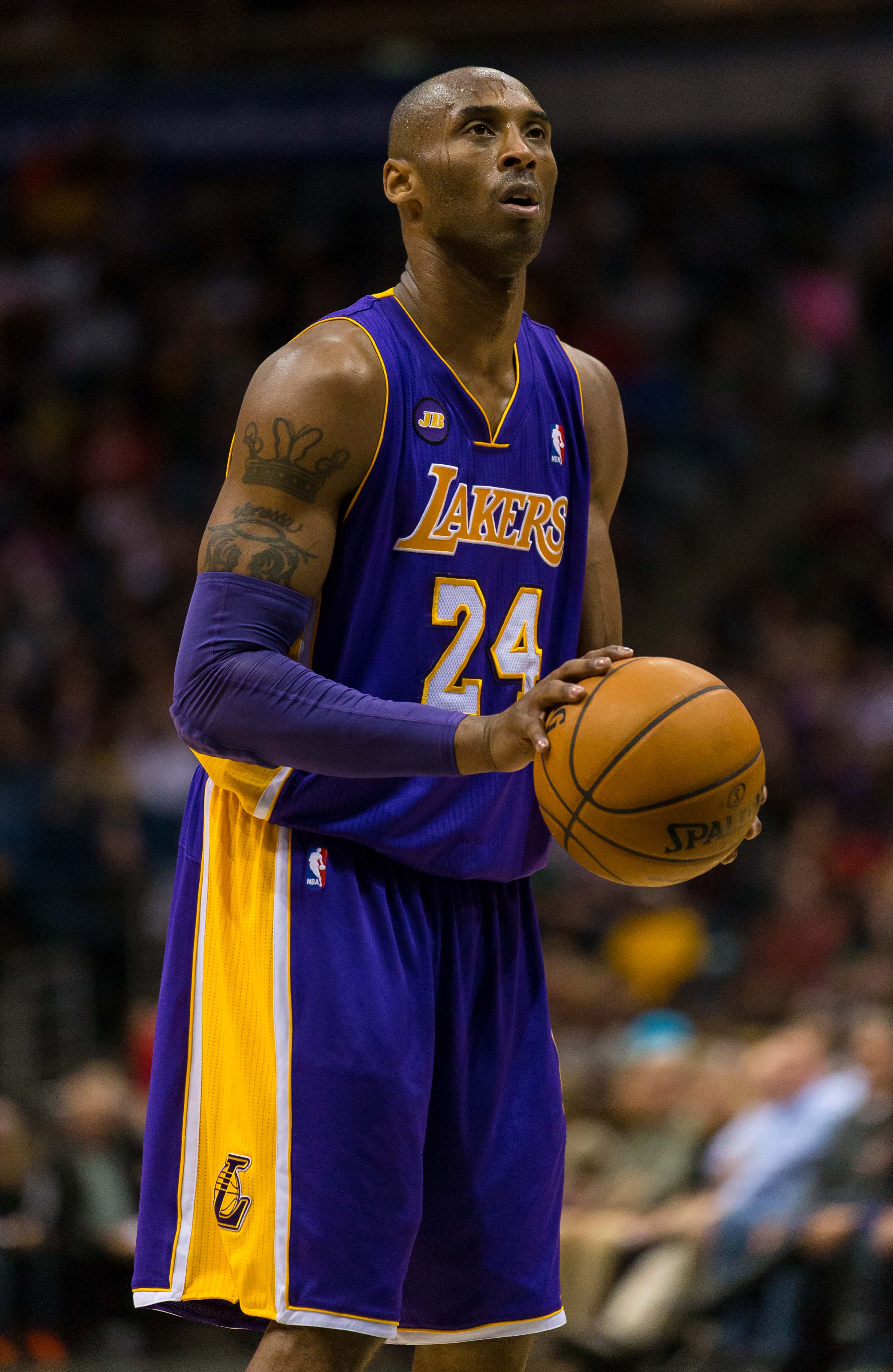
Not much was known about Kobe Bryant before the deal that sent him to Los Angeles for his entire career. All anyone knew was that he was out of Lower Merion High School in Philadelphia and Jerry West loved him. When Jerry West speaks, you listen, especially in an executive role. Kobe was drafted to the Charlotte Hornets but Head Coach Dave Cowens infamously said that he wasn’t needed there, according to Kobe. This helped pave the way for a straight-up deal that sent Vlade Divac to Charlotte and Bryant to Los Angeles. What ensued is one of the greatest careers in NBA history.
Kobe would go on to become an MVP, a 5x NBA champion, and a 2x Finals MVP. He became an international icon. Everybody was talking about Kobe Bryant day and night. When we got to school in the morning, we would circle up with our friends and talk about the previous night’s NBA action. Kobe would always end up being the topic of conversation. Kobe commanded excellence and would accept nothing less than maximum effort from everyone around him from the executives right on down to the water boy. He was the epitome of greatness and people wanted to be him almost as much as they wanted to be like Mike. Los Angeles is forever indebted to Jerry West’s eye for talent and his acquisition of Kobe Bryant.
Memphis Grizzlies – Zach Randolph
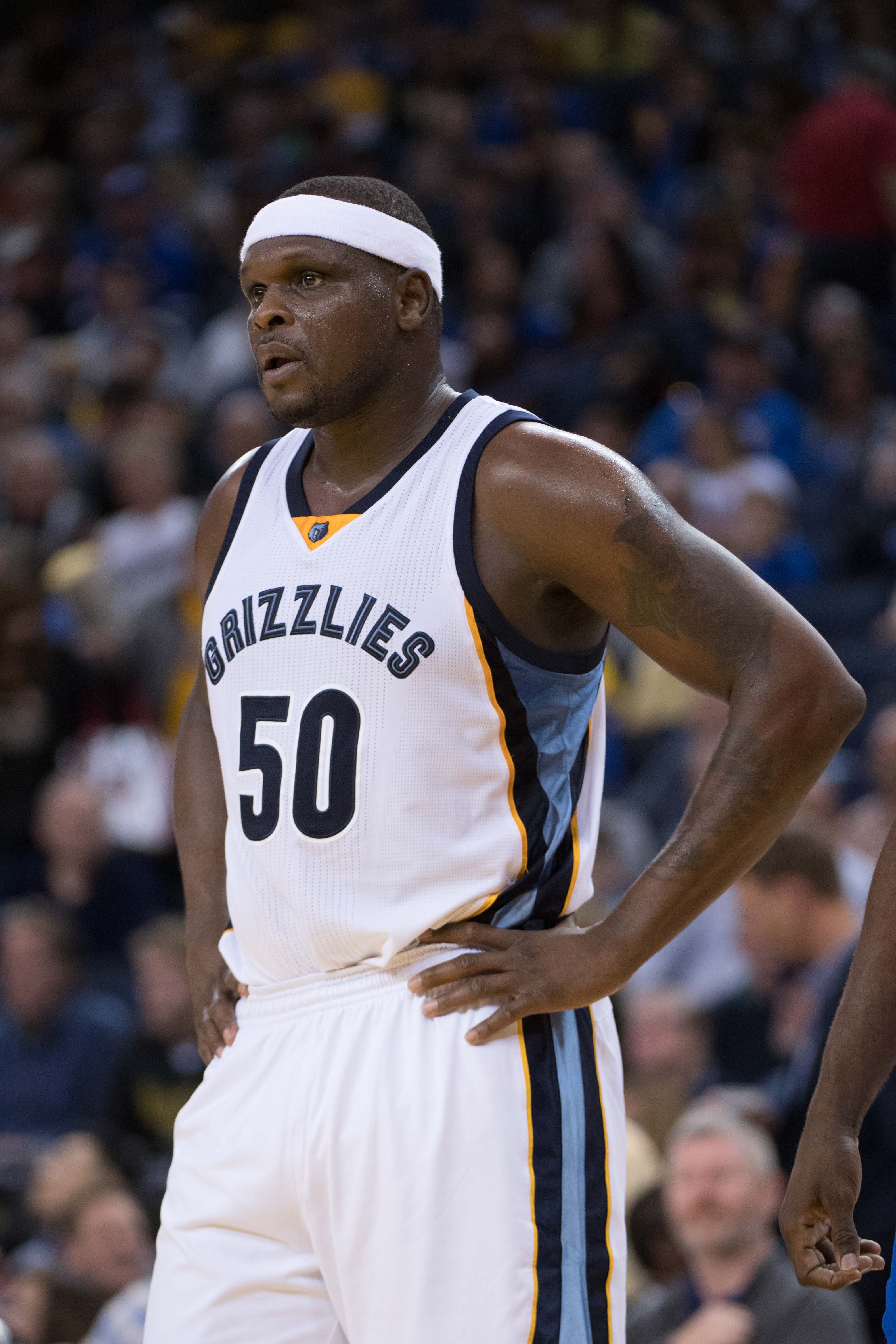
Zach Randolph had been a bully-ball big for 8 seasons in the NBA before he arrived in Memphis. He was a vital member of the early 2000s Trail Blazers teams that were a tough matchup for anyone who opposed them. He was then the same player for the Knicks, although they were never even playoff contenders when he was there. He was still a consistent 20.0 PPG and 10.0 RPG threat every night, but his legacy would shift in 2009 when he was traded from the Clippers to the Grizzlies for Quentin Richardson.
Randolph would blossom into an All-Star in Memphis as a part of the “Grit and Grind Grizz” in the early 2010s. He was named an All-Star for the first time in his first season, with Memphis averaging 20.8 PPG and 11.7 RPG. The following season, he would be named to the first and only All-NBA Team of his career as well. He would be named an All-Star again in 2012-13 as he helped the Grizzlies reach the Western Conference Finals for the first time. The Grizzlies would be swept by the Spurs, but the memories were made and the impressions are everlasting on Randolph’s impact on the franchise.
Miami Heat – LeBron James
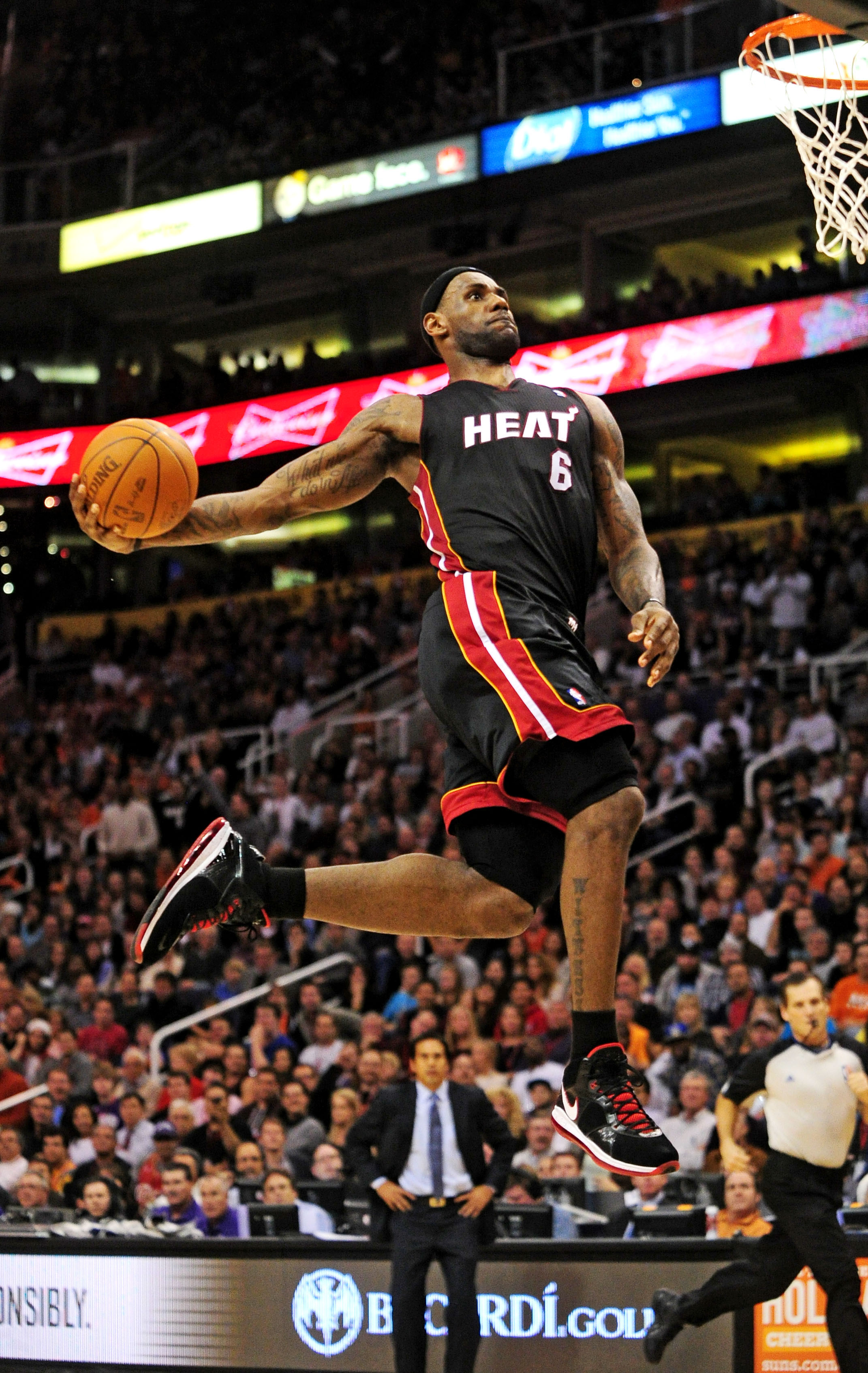
Ask any NBA fan that was around in 2010, they could tell you exactly where they were when LeBron James decided to take his talents to South Beach. It shocked the NBA world because the thought among fans, media, and even players was that LeBron would be a Cleveland lifer who did his best to deliver the city their first title. He eventually did just that, but not before teaming up with Dwyane Wade and Chris Bosh in Miami. The Heat signed James to a 4-year, $153.5 deal which James would deliver on to the fullest.
LeBron spent 4 years in Miami, where he helped the team reach 4 NBA Finals in 4 seasons. He won back-to-back MVP awards in 2012 and 2013 with the Heat coincidentally the same years he was named Finals MVP in his first 2 championship wins. Everyone knows about the 2011 NBA Finals meltdown where he choked away a 2-0 lead to the Dallas Mavericks and lost in 6 games. In 2012, the Heat would defeat the Thunder and in 2013 they would defeat the Spurs for back-to-back championship runs. James would get the Heat back to the Finals in 2014, but they would fall in 4 games to the San Antonio Spurs. LeBron would move on back to Cleveland once his contract was up, but Miami fans everywhere are eternally grateful he chose them for that period.
Milwaukee Bucks – Oscar Robertson
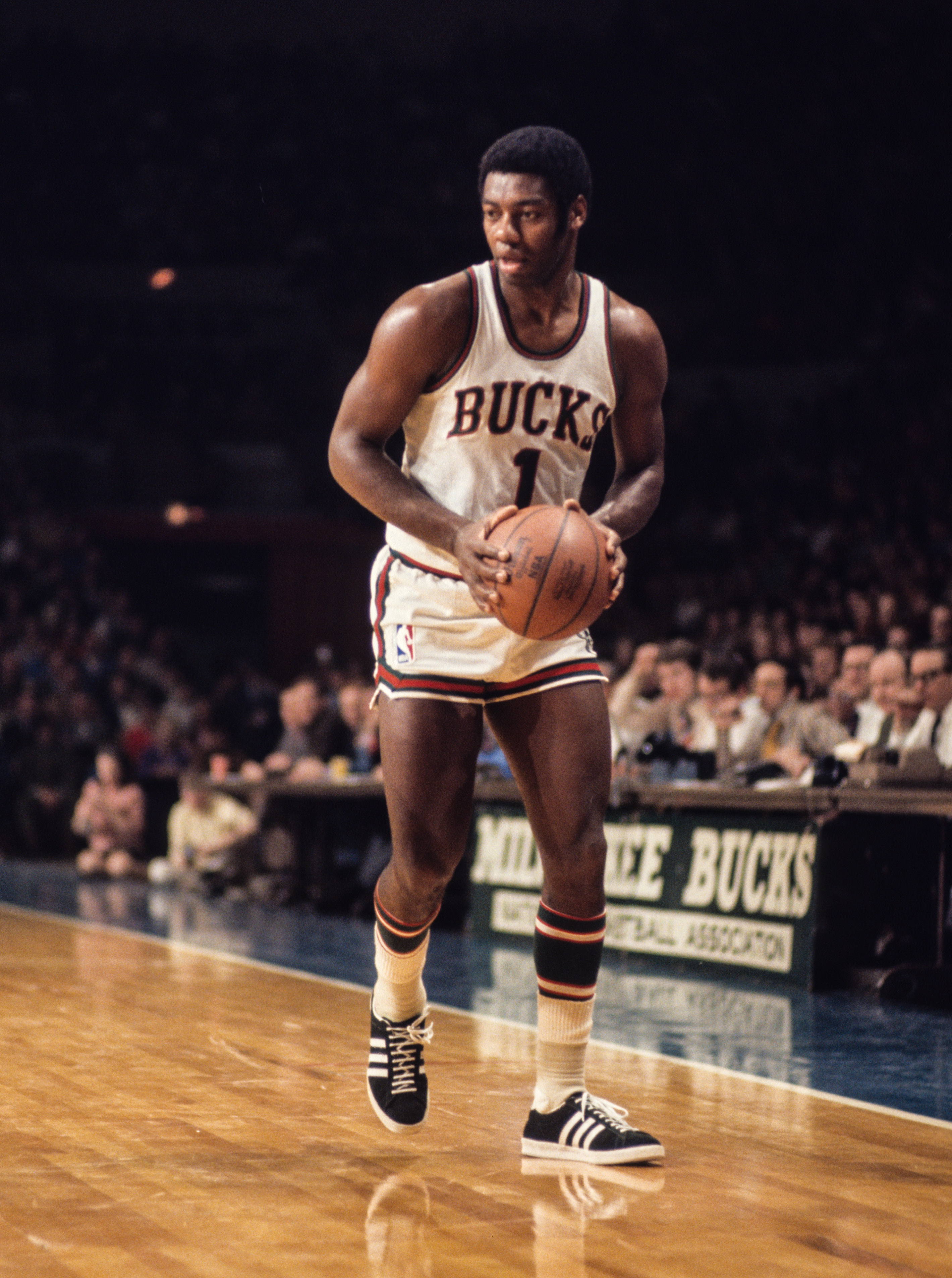
Oscar Robertson was the best guard in basketball prior to joining the Milwaukee Bucks in the 1970-71 season. In just his 2nd season, he became the only player in NBA history to average a triple-double for an entire season prior to Russell Westbrook doing it in 2017. As a member of the Cincinnati Royals, Oscar led the NBA in assists in 7 out of his 10 seasons with the team. The problem was that they never had enough to legitimately compete for a championship. In April of 1970, Robertson was dealt to the Milwaukee Bucks for Charlie Paulk and Flynn Robinson, and his prayers were answered.
In his first season with the Bucks alongside Kareem Abdul-Jabbar, Robertson accomplished the exact thing that had been eluding him for a decade. He averaged 25.3 PPG, 6.1 RPG, and 8.1 APG while helping the Bucks to a 66-16 record in the regular season. In the playoffs, The Bucks ran through the competition and Oscar had a berth in his first career NBA Finals. In the Finals, he averaged 23.5 PPG, 5.0 RPG, and 9.5 APG as the Bucks swept the Baltimore Bullets. Robertson had completed what he had long set out to do. His immediate impact and championship run make him an easy choice for us today on our list.
Minnesota Timberwolves – Kevin Love
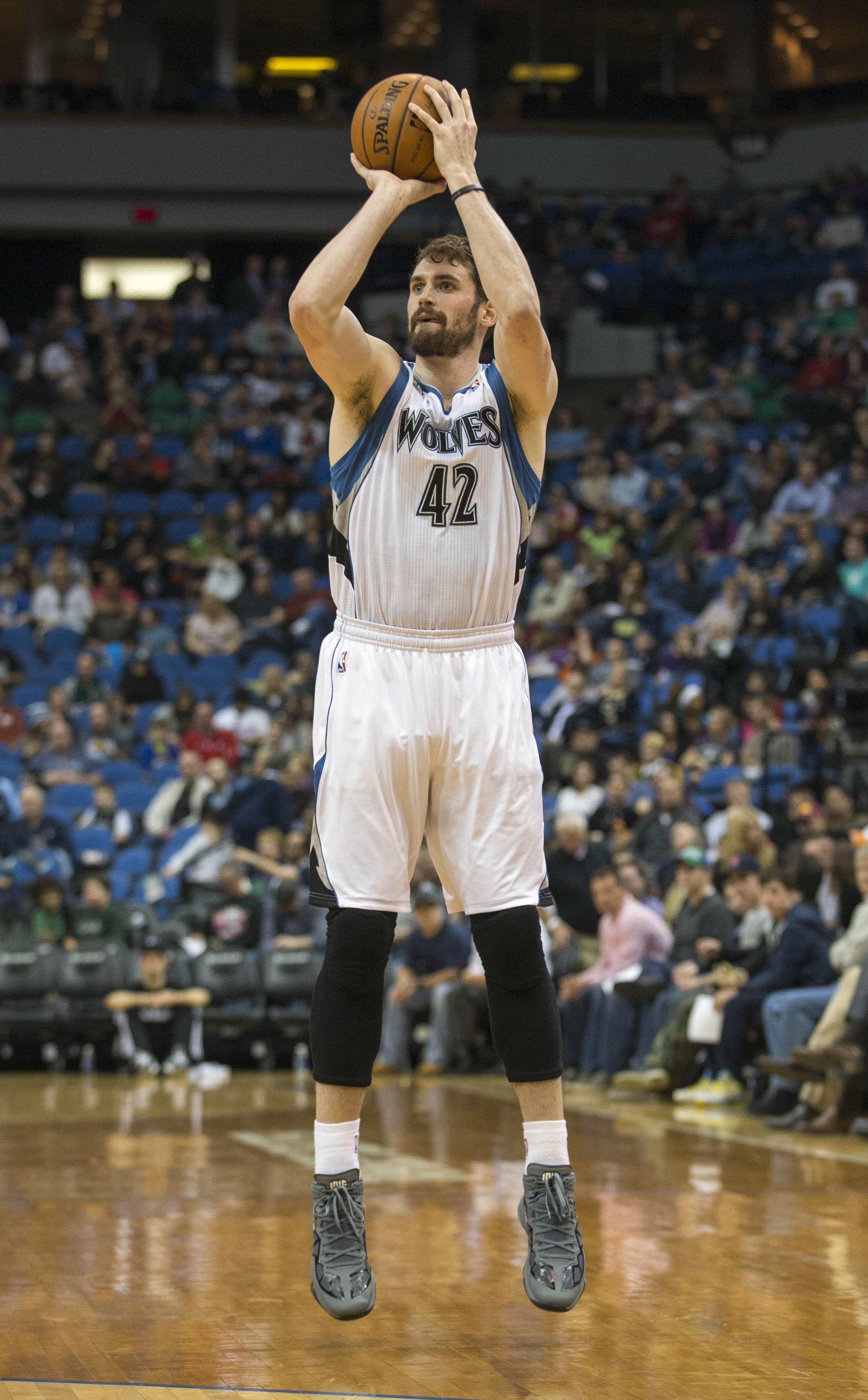
Kevin Love was a standout at UCLA before being selected 5th overall by the Memphis Grizzlies in the 2008 NBA Draft. The Grizzlies had no idea what they had as they traded him to the Timberwolves on draft night. He was sent to Minnesota along with Brian Cardinal, Jason Collins, and Mike Miller in exchange for Antoine Walker, O. J. Mayo, Greg Buckner, and Marko Jaric. He made a significant impact almost immediately and was the new face of a franchise that had a long history of misery.
Love was not a starter immediately in Minnesota, but by the time he was, he has bloomed into an All-Star. In his first full season as the starter, Love averaged 20.2 PPG and led the league with 15.2 RPG. He became a double-double machine, recording 256 of them in 6 seasons with the team. He also developed into an inside-outside threat the likes of the franchise hadn’t seen since Kevin Garnett. In his 6 seasons with the Timberwolves, Love averaged 19.2 PPG and 12.2 RPG while unfortunately never making the playoffs. Lack of success doesn’t hinder the fact that he was the best trade/signing that Minnesota ever made.
New Orleans Pelicans – Brandon Ingram
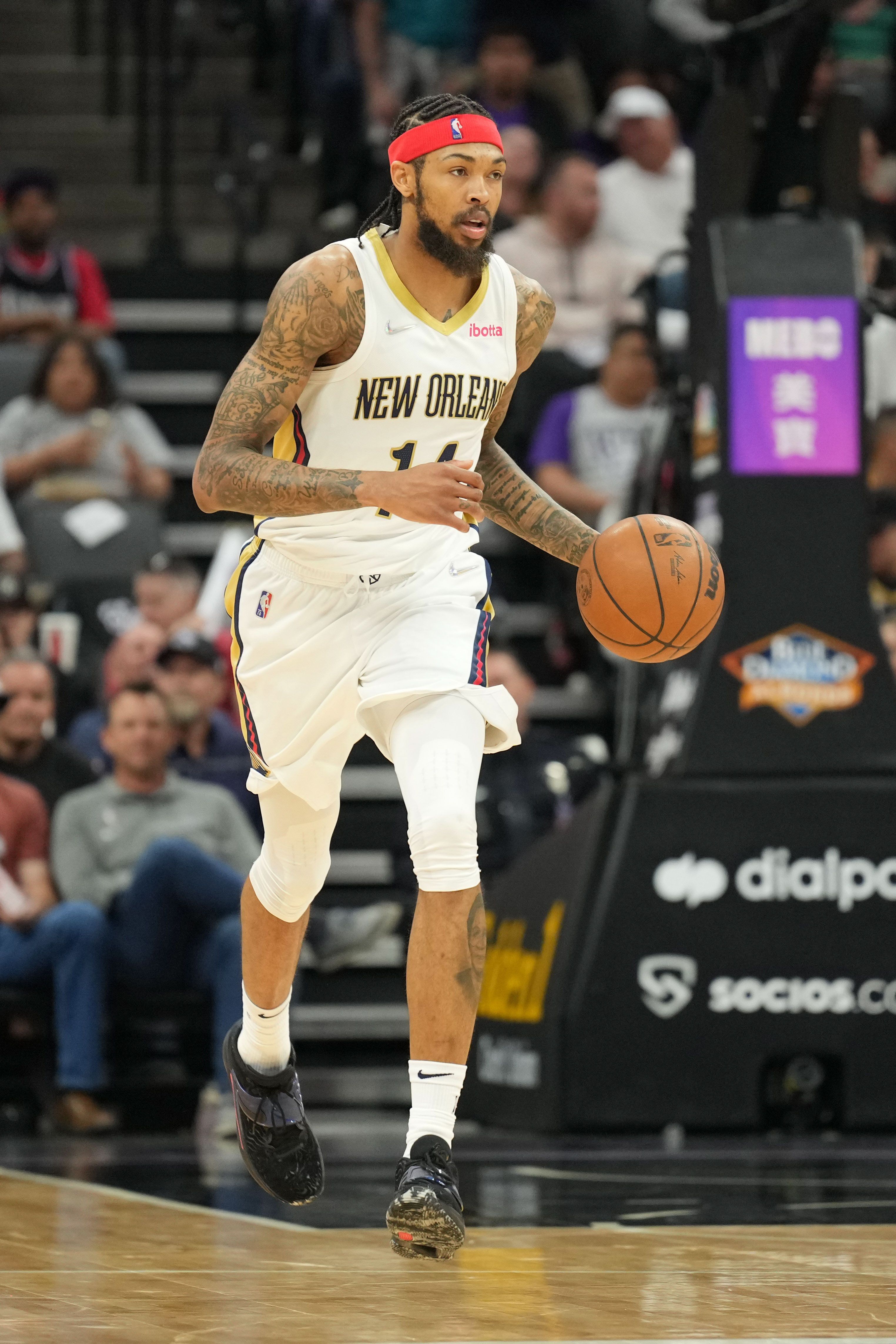
The New Orleans Pelicans do not have a long history of making great deals or signing big names in free agency. When they decided to appease their franchise star Anthony Davis in the 2019 offseason, they knew they had to bring back the right pieces to rebuild around. They did just that when they sent Davis to the Lakers and got a haul featuring Ingram in return. Ingram has yet to make the Pelicans forget about Davis, but the way it is trending, that time could be coming very soon.
In his first season with the Pelicans, Ingram earned his first and only All-Star selection. He averaged 23.8 PPG, 6.1 RPG, and 4.2 APG in 62 games played that season. This past season, Ingram’s development, along with the pending return of Zion Williamson and the trade for CJ McCollum, have given New Orleans their biggest buzz since drafting Davis in 2012. The Pelicans made the playoffs for the first time since 2018, and Ingram put on a show. The team pushed the Suns to 6 games while Ingram averaged 27.0 PPG, 6.2 RPG, and 6.2 APG. They didn’t get the result they wanted, but they left hope for the upcoming 2022-23 season for sure.
New York Knicks – Carmelo Anthony
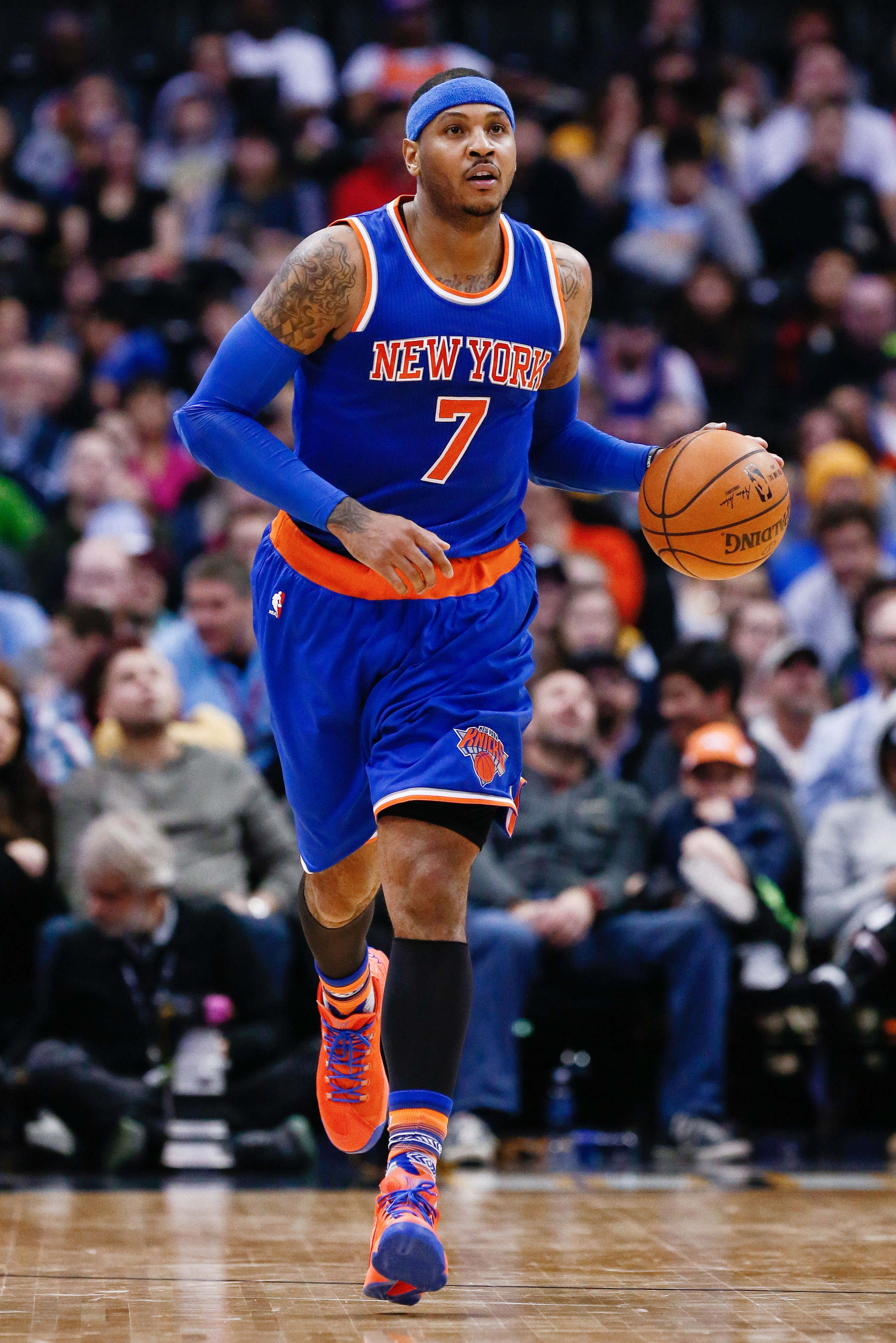
This is probably the first semi-controversial pick on our list, but Carmelo Anthony’s trade to the New York Knicks was their best transaction. At the time, it seemed like New York was giving up too much to land the scoring connoisseur, but he quickly made them forget all of that. It was well known when Carmelo requested a trade from the only team he had ever played for, the Denver Nuggets, that his first choice was to come back home and play in MSG. He idolized Knicks legend, Bernard King, as a kid and for him, it came full circle when Denver pulled the trigger on the deal that sent him to New York.
Anthony led the Knicks to the playoffs in each of his first 2 seasons with the team, but both of those runs ended in first-round losses. The following season in 2013, Carmelo won the scoring title with 28.7 PPG and led the Knicks to the playoffs yet again. He averaged 28.8 PPG in the playoffs and earned the Knicks their first playoff series win since the early 2000s. He would be named an All-Star all 7 seasons that he was in New York and named to an All-NBA Team twice.
Oklahoma City Thunder – Spencer Haywood
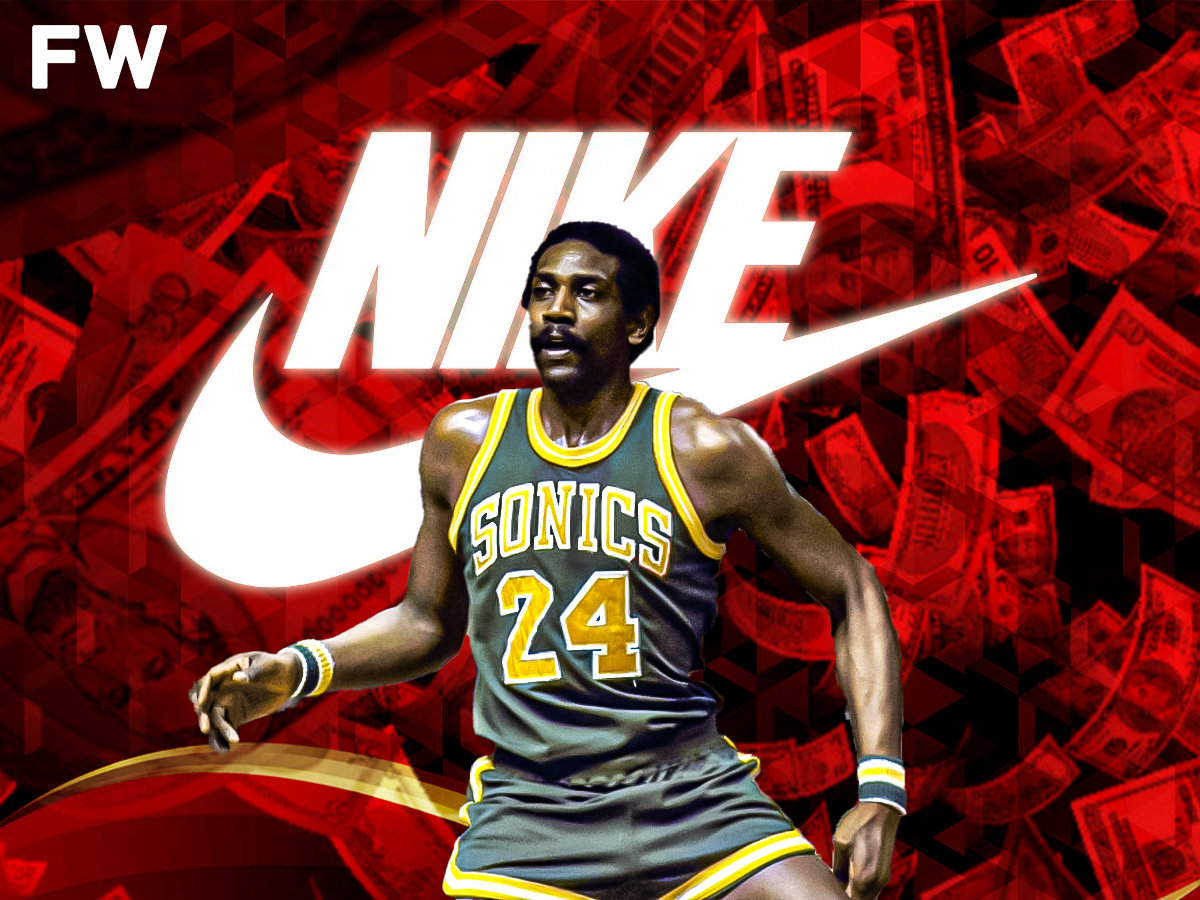
Spencer Haywood was the best player in the ABA during the 1969-70 season, leading the league in both scoring and rebounds. He averaged 30.0 PPG and 19.5 RPG that season and became a free agent shortly after. Haywood fought for players to have the right to be drafted before the normal 4-year window that was in place. In 1970, Haywood left the ABA for the NBA and signed a 6-year, $1.5 million contract with the Seattle SuperSonics.
Haywood played all 6 years of his contract with Seattle, becoming an All-Star in 5 of them. He averaged 24.9 PPG, 12.1 RPG, and 1.5 BPG in those six seasons. The Sonics made the playoffs just once during his tenure and made the second round. Haywood made 2 All-NBA First Teams and 2 All-NBA Second Teams as well. He also holds the single-season records for PPG and RPG from his 1973-74 campaign, where he averaged 29.2 PPG and 13.4 RPG. His stellar play and the landmark decision made by the Supreme Court due to his efforts land him as the Thunder/Sonics’ best acquisition.
Orlando Magic – Tracy McGrady
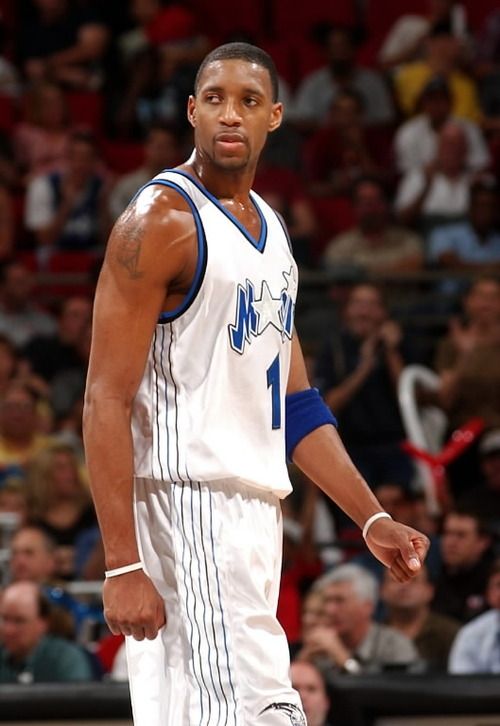
The Orlando Magic were looking to shake things up and quickly having dealt with the fallout from the losses of both Penny Hardaway and Shaquille O’Neal. In the 2000 offseason that is exactly what they did signing and trading for both Tracy McGrady and Grant Hill. It was no secret that McGrady wanted out of Toronto, and his hometown of Orlando was certainly on his radar. McGrady was traded to Orlando for a 2005 first-round pick despite heavy contention from Miami for his services. This is where McGrady would begin to make a name for himself throughout the league.
The NBA knew that McGrady was talented, but I don’t know if they were expecting what was to come. McGrady became an All-Star in his first season with the Magic averaging 26.8 PPG, 7.5 RPG, and 4.6 APG. He would also be named the NBA’s Most Improved Player. Two years later, he would win his first of back-to-back scoring titles with 32.1 PPG. The next year, he averaged 28.0 PPG. He was named an All-Star all 4 seasons that he was with the team and he was named to 4 All-NBA Teams as well. He led the Magic to the playoffs 3 out of the 4 seasons with Orlando but failed to make it out of the first round under Head Coach Doc Rivers. McGrady was the perfect segue from the Shaq and Penny era, making him Orlando’s greatest acquisition.
Philadelphia 76ers – Julius Erving
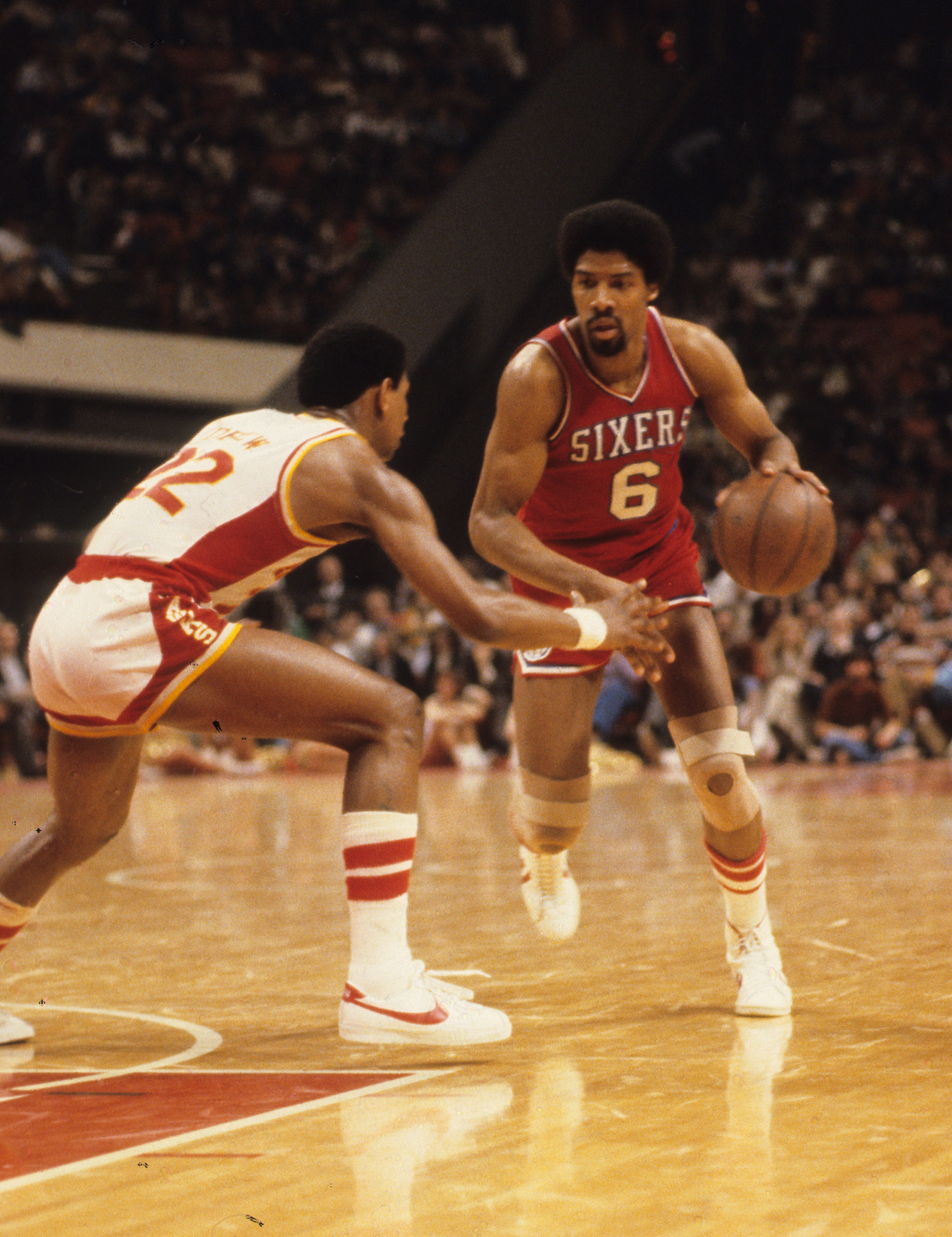
After 5 seasons in the ABA from 1972 to 1976, Julius Erving finally thought it was time to try his hand in the NBA and left with the New York Nets in the merger. In the ABA, Dr. J won 3 scoring titles in 5 seasons and averaged 28.7 PPG. His rights were sold by the Nets to the 76ers in October of 1976, where he would spend the remaining 11 years of his career. In Philly, Erving would become a global icon, building on the legacy he was already building in the ABA.
Erving would never take home a scoring title with the Sixers, but he would average over 20.0 PPG for the 9 seasons with the team. After winning two titles in the ABA with the Nets, all that was left to do was to win one in the NBA. In 1983, that is exactly what he did. In the regular season, he averaged 21.4 PPG and 6.8 RPG, helping the Sixers to a 65-17 record. Alongside Moses Malone, Erving led the Sixers to the Finals where they matched up with the Lakers. In the 4-game sweep, Erving averaged 19.0 PPG, 8.5 RPG, and 5.0 APG to help the sixers win their 3rd and last title in franchise history.
Phoenix Suns – Steve Nash

Steve Nash was drafted by the Suns in 1996 before being traded to Dallas in 1998. He would spend 6 years in Dallas before deciding to return to the team that drafted him in 2004. Nash’s free agent deal was a 5-year, $65 million deal that he decided to extend by 2 years after it was up. This would end up being the best deal that Phoenix ever made.
Steve Nash’s second season was the birth of one of the greatest playmakers the game has ever seen. He had shown flashes in Dallas, but nothing to the extent we saw in Nash’s second stint in Phoenix. He led the NBA 5 times out of 8 seasons with the Suns and led them to the playoffs 5 times as well. He took home back-to-back MVP awards in 2005 and 2006. In 2006, Nash led his team to the Western Conference Finals. He also joined the 50/40/90 club 4 times while manning the Suns’ offense. Although the Suns were never able to hoist the Larry O’Brien Trophy, Nash made a lasting impact on the franchise as one of the most exciting eras in its team’s history.
Portland Trail Blazers – LaMarcus Aldridge
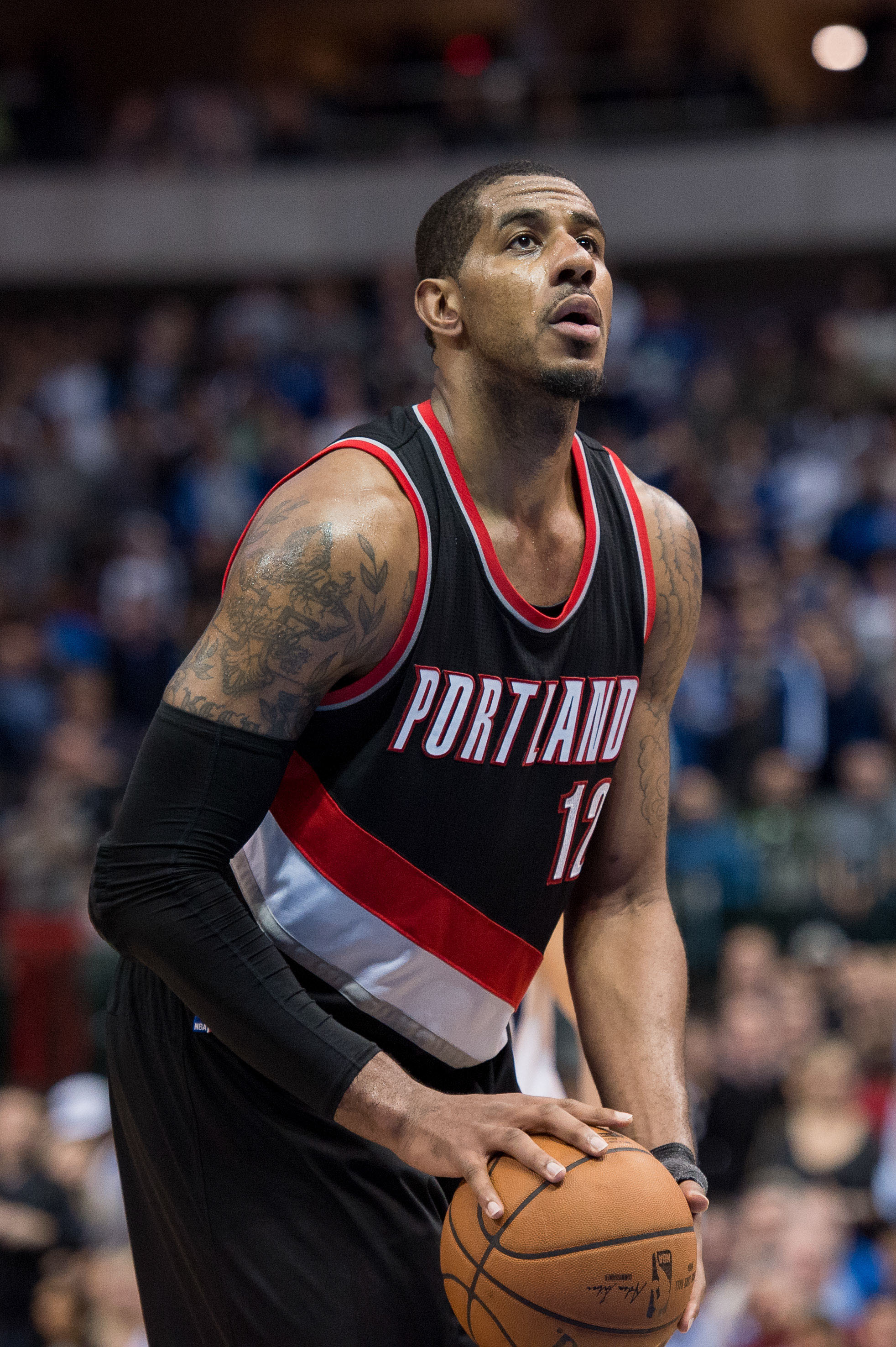
Many people forget that LaMarcus Aldridge was drafted by the Chicago Bulls in 2006 with the second pick of the draft. That is probably because he was traded moments later to the Portland Trail Blazers for Tyrus Thomas and Viktor Khryapa. The pick saw him paired with budding superstar Brandon Roy to give them another boost in the paint alongside Zach Randolph. A couple of years later, the Blazers selected Greg Oden to be his frontcourt companion. No one could foresee what was coming.
It took a few seasons for Aldridge to bloom into an All-Star, but once he did, he never looked back. By the time Aldridge reached that level, his teammates were suffering from what would be career-shortening injuries. Roy’s knees began to degenerate and Oden’s feet could never hold up to the grind of an NBA season. Together they were nearly unbeatable, but the problem was, they were rarely together. When the team drafted Damian Lillard, that is when Aldridge finally had a teammate who could help him make the Blazers succeed. They reached the Western Conference Semifinals Together in 2016 only to fall in 5 games to the Warriors. In his 9 seasons with the team, he averaged 19.4 PPG and 8.4 RPG while reaching the playoffs 5 times.
Sacramento Kings – Chris Webber

Chris Webber had a few tumultuous seasons in the NBA before landing in Sacramento. Webber took home Rookie of the Year in 1993-94 but was dealt in the offseason due to a rocky relationship with Head Coach Don Nelson. Webber spent 4 seasons with Washington before being dealt to the Kings in 1998. He was sent to Sacramento in exchange for Mitch Richmond and Otis Thorpe. It would be the best move that Sacramento ever made.
In 4 out of his first 6 seasons with the Kings, Webber was named an All-Star. He helped them reach the playoffs every season he was there, including a Western Conference Finals berth in 2002. In his 6-and-a-half season with the Kings, Webber averaged 23.5 PPG, 10.6 RPG, and 4.5 APG. He also added 1.5 SPG and 1.5 BPG. He led the league in RPG in 2000 and was named to 5 All-NBA Teams as well. As one of the best power forwards in the NBA, in a league full of talent at that position makes Webber Sacramento’s best acquisition.
San Antonio Spurs – Kawhi Leonard
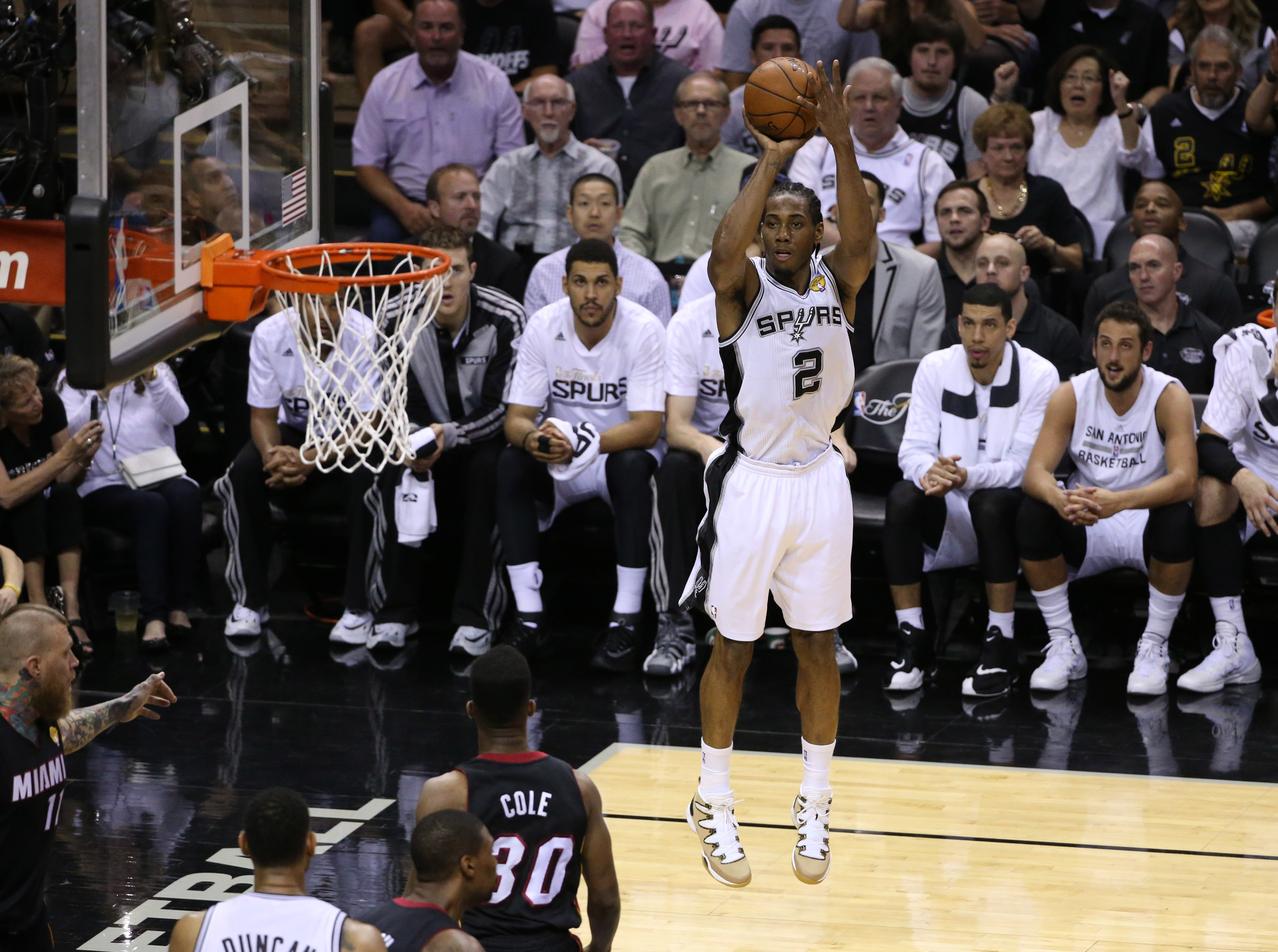
Coming out of San Diego State, it was unclear what type of NBA player was going to be. When the Indiana Pacers selected him 15th overall in 2011, it was clear that they didn’t have a clue either. Shortly after being drafted to Indiana, they dealt Kawhi to the Spurs along with Davis Bertans and Erazem Lorbek for George Hill. The Pacers happened to be higher on Hill than Kawhi and that wasn’t such a bad take at the time. What has transpired since has made it a bad take of epic proportions.
Kawhi’s time in San Antonio may have ended on a sour note, but man, was it sweet for a few years. Kawhi’s coming-out party was at the 2014 NBA Finals when matched up against the Miami Heat and LeBron James. We have all seen the tape of LeBron visibly frustrated when Kawhi checks into the game during these Finals. That’s because Kawhi had LeBron as confused as he has ever been and was rewarded the Finals MVP for his defensive efforts on James. He followed that up with back-to-back Defensive Player of the Year awards in 2015 and 2016. The draft night that landed Kawhi in San Antonio is their best move via free agency or trade.
Toronto Raptors – Kawhi Leonard
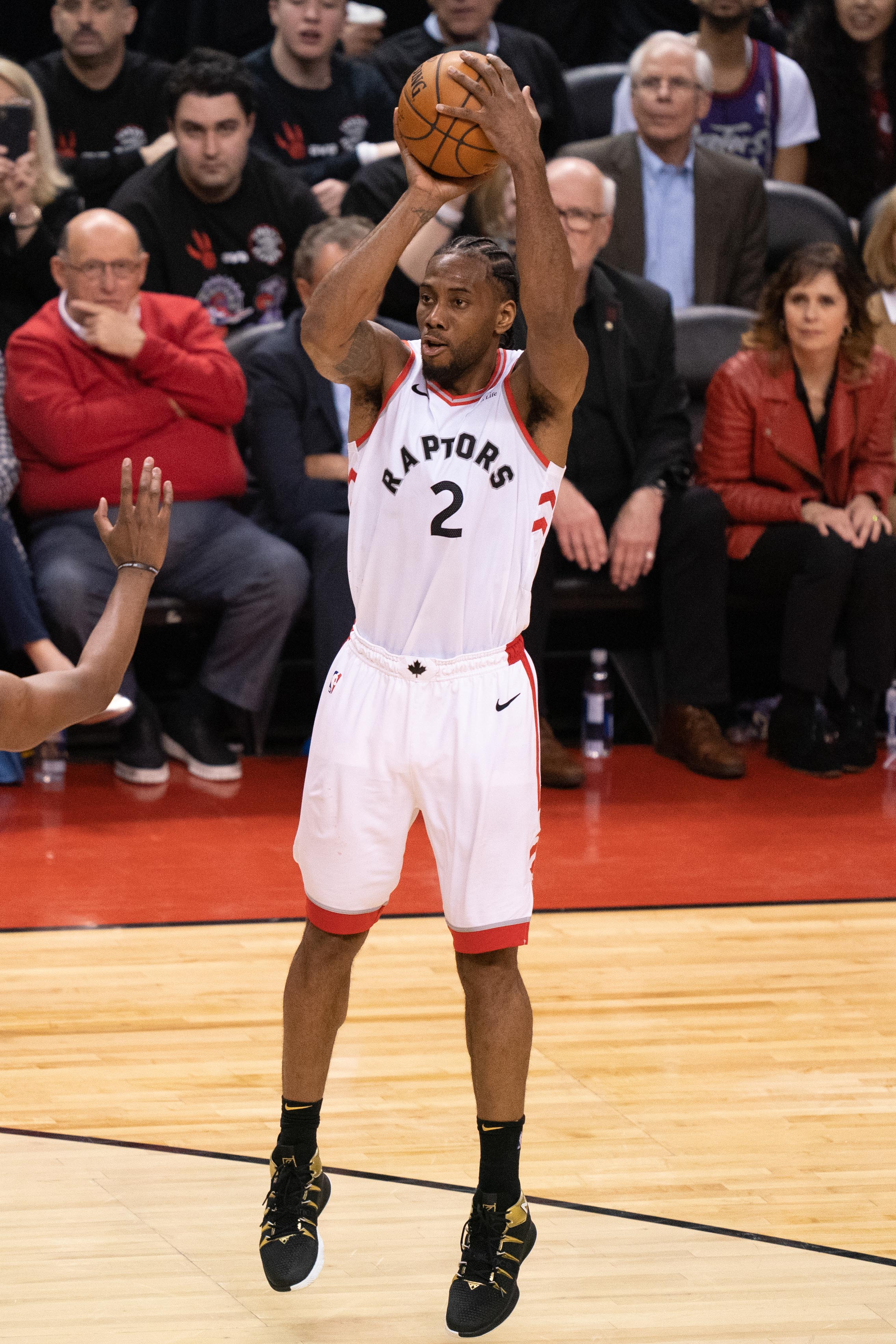
Kawhi Leonard’s tenure in San Antonio ended about as tumultuously as a player-organization relationship can end. He pretty much forced his way out of San Antonio, claiming he lost all trust within the organization. The team that benefited the most from this was the Toronto Raptors. The Raptors ended up taking a major gamble by sending fan-favorite DeMar DeRozan, Jakob Poeltl, and a first-round pick to San Antonio for Leonard and Danny Green. The move ended up being the smartest one in franchise history.
Kawhi ended up spending just one season with the Raptors, but it happened to be the best single-season in Raptors history. Kawhi averaged 26.6 PPG, 7.3 RPG, 3.3 APG, and 1.8 SPG. He was named an All-Star and was named to both the All-NBA Second Team and All-Defensive Second Team. During the playoffs, Kawhi stepped it up to 30.5 PPG and 9.1 RPG and gave the Raptors their first-ever Finals berth. Kawhi and the Raptors needed just 6 games to take down the injury-riddled Warriors and capture their first title in franchise history. Kawhi averaged 28.5 PPG, 9.8 RPG, and 4.2 APG to capture the Finals MVP award.
Utah Jazz – Carlos Boozer
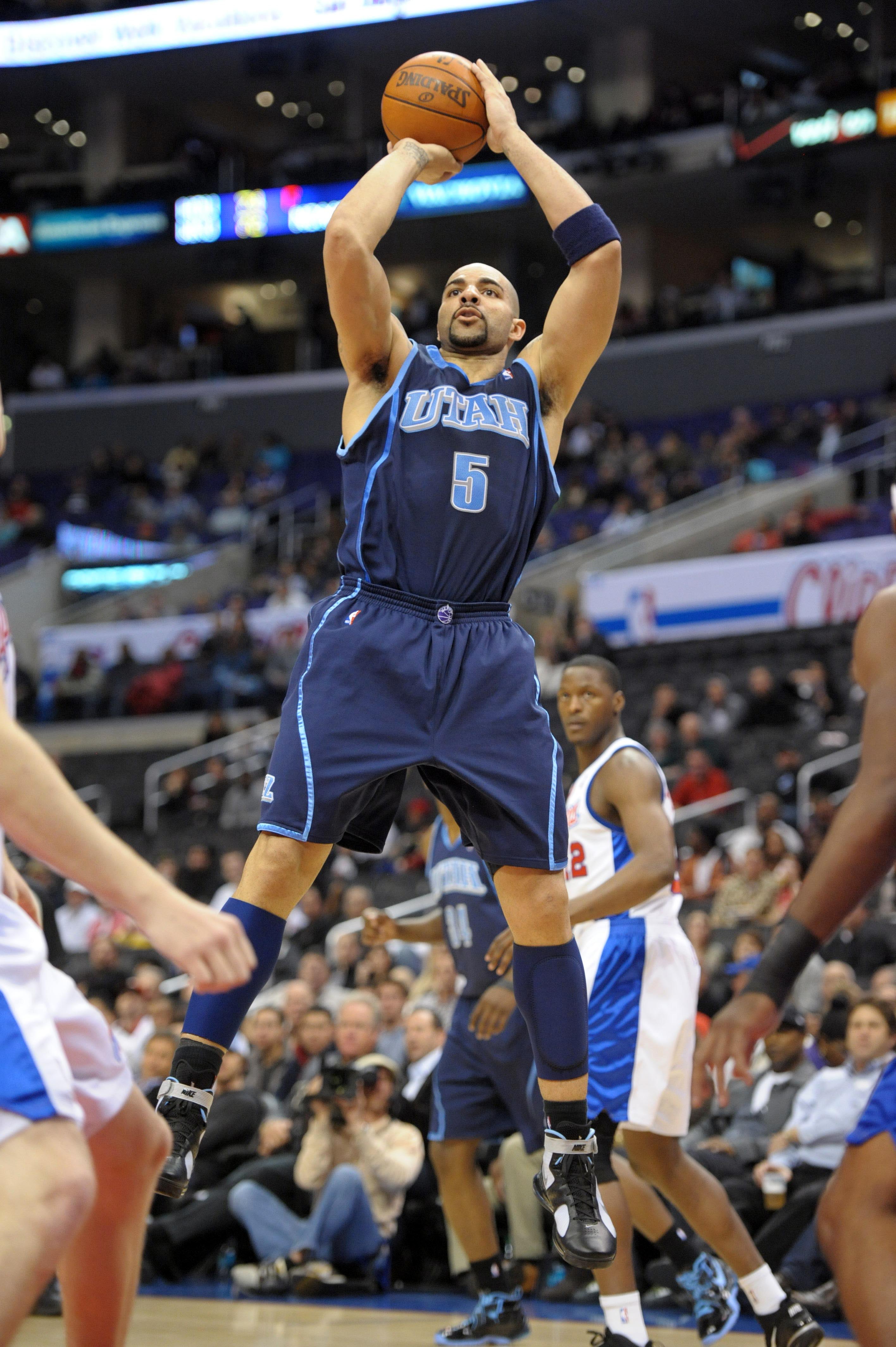
For the first two seasons of his career, Carlos Boozer played alongside LeBron James on the Cleveland Cavaliers. In the free agency period of 2004, Boozer decided to leave Cleveland and instead head to Utah, signing a 6-year $68 million offer sheet which the Cavs failed to match. The Cavaliers did try to bring him back down to the very last minute, but Boozer decided to go with the money. A few seasons later, when point guard Deron Williams arrived is when Boozer found his game and hit his peak.
Before Williams’ arrival, Boozer was a solid big for Utah averaging 17.2 PPG and 8.8 RPG over those 2 seasons. In his first season with Williams, Boozer became an All-Star for the first time and averaged 20.9 PPG and 11.7 RPG. He earned another All-Star selection the following season as well and was named to the All-NBA Third Team. In his 6 seasons with Utah, they went to the playoffs 4 times and Boozer averaged 19.3 PPG and 10.5 RPG.
Washington Wizards – Elvin Hayes
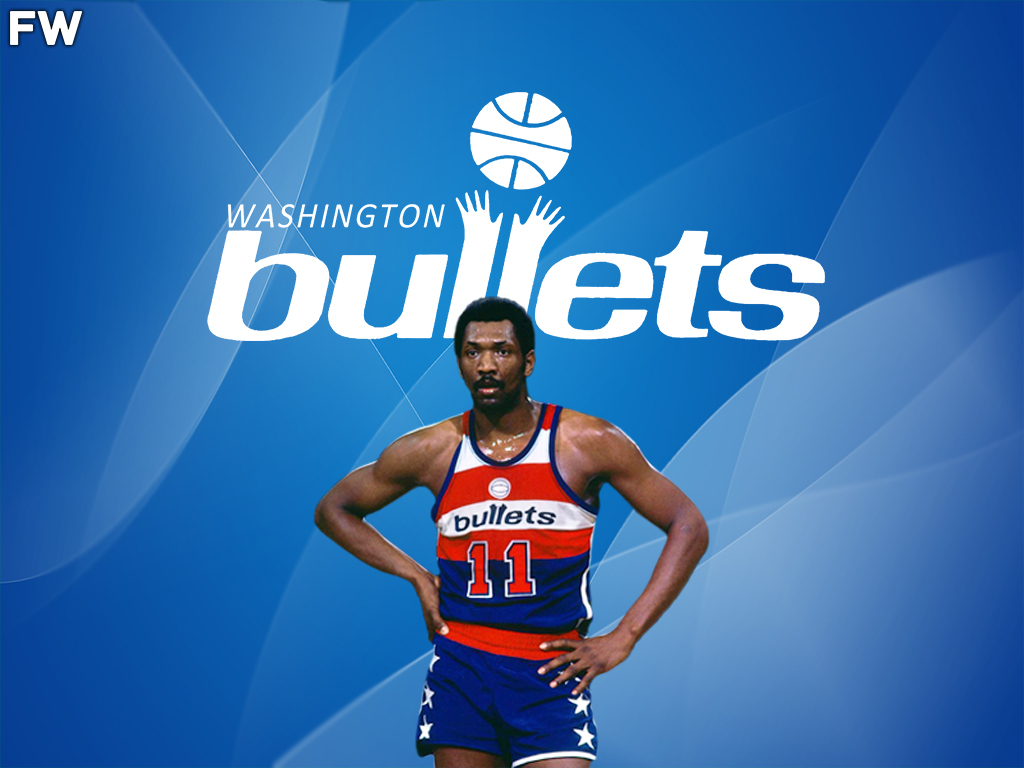
Before Elvin Hayes arrived in Washington, he was already considered one of the best scorers and rebounders in the game. He had led the league in scoring his rookie year and also became one of the best defenders at the power forward position. In 1974, Hayes was traded to the Washington Bullets from the Houston Rockets in exchange for fellow All-Star, Jack Marin. The move was met with backlash and complaints about his fit, but Hayes made the doubters soon forget what they were upset about.
From the moment that Hayes stepped on the floor from Washington, the team was exponentially season. Their record went from below .500 to a team that won 52 games in just one season. They would go on to the NBA Finals that season as well, but lose to the Golden State Warriors and Rick Barry. Hayes’ addition made the Bullets juggernauts of the league in the late 70s as they would again find themselves in the NBA Finals in 1978. This time they would take home the championship in 7 games over the Seattle SuperSonics. Hayes led the team with 20.7 PPG and 11.9 RPG but was not named Finals MVP. That honor went to teammate Wes Unseld. In his 9 seasons with the Bullets, Hayes averaged 21.3 PPG and 12.7 RPG. He was named an All-Star 6 times and All-NBA 4 times.

